The Words Have “Spunk” The Words Have “Spunk”







By Belaynesh Shiferaw
WASHINGTON (HUNS) — In a convention hall illuminated by soft stage lights, educators and advocates gathered with purpose and resolve to close out the Congressional Black Caucus Foundation’s 54th Annual Legislative Conference (ALC). Together, they outlined a vision that extended beyond classrooms — a vision grounded in truth, fairness and shared responsibility. In a united front, they called to reclaim schools and public education as beacons of hope and the bedrock of American democracy.
Princess Moss, vice president of the National Education Association (NEA), which sponsored the session, opened the conversation with a pointed warning.
“Every day, our educators are being asked to do more with less,” Moss said. “Disinformation, gun violence and ICE raids are frightening students away from schools. School is supposed to be the safest place in America.”
“At a time like this, we need all hands on deck,” she added later, alluding to the session’s title: “The State of Education: It’s All Hands on Deck for Our Democracy – For Our Educators. For Our Students. For Our Future.”
The room stayed energized and united. What began as a one-hour session stretched an hour beyond its original schedule. Panelists included NEA President Becky Pringle; the Rev. Shavon Arline-Bradley, president and CEO of the National Council of Negro Women
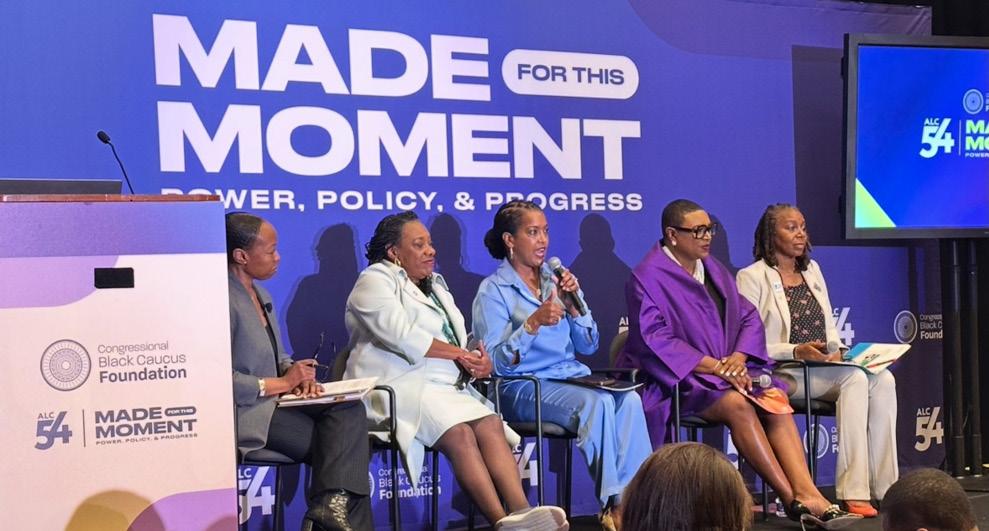
(NCNW); and U.S. Rep. Jahana Hayes, a former teacher and the first Black woman to represent Connecticut in Congress.
The speakers urged immediate investment in teachers, stronger protections for vulnerable students and policy rooted in equity and truth. From rising disinformation to immigration raids that drive children away from schools, they also described a growing climate of fear and pressure, and they emphasized the need to empower educators as leaders inside and outside the classroom.
Earlier this year, President Trump called
for a 15% cut to overall funding within the proposed 2026 Department of Education budget. The proposal would eliminate all funding for safe schools and citizenship programs, as well as programs supporting English language learners. It also slashes more than half of the funding for innovation and improvement efforts, including “arts education, community engagement centers and teacher and student incentive programs.”
Moss stressed that funding education isn’t just about the numbers.
“When educators are supported, students thrive,” she said. “And flourishing communities keep our democracy strong.”
Nicole Austin-Hillery, president and CEO of the CBCF, issued a challenge to session participants.
“This ALC is not about having good conversation,” she said. “It’s about planning, strategy and walking out of this building with a clear agenda.”
The challenge was in line with the theme that Austin-Hillery coined for this year’s ALC: “Made for This Moment,” in response to the growing urgency sur-
rounding federal policy. She spoke directly to the importance of educators in shaping America’s future.
“Were it not for them, we would not have the democracy we depend upon,” Austin-Hillery said. “They are the ones who teach our future leaders the truth and the courage to lead.”
Hayes echoed that urgency.
“We have to do more,” the congresswoman said. “Now is the moment to do it. I am so frustrated with my colleagues acting like we have all day.”
“We are all out of time. The kids are counting on us to get it right the first time.”
The audience rose in cheers, with standing ovations and tears on the faces of attendees in the front rows.
The conversation also addressed Executive Order 14190, Ending Radical Indoctrination in K–12 Schooling, one of the first orders from the Trump administration’s return. The order eliminates federal funding for what it deems “discriminatory equity ideology,” including diversity, equity and inclusion (DEI) programs and teaching about structural racism. It also reestablishes the 1776 Commission, which promotes only what it defines as “patriotic American history.”
Pringle and Arline-Bradley emphasized the need to teach all American history, including “Black, Native American and Latin history” in its full truth.
“Public education was never designed to teach minorities,” Pringle said. “We have to transform it into something racially and socially just that prepares every student. And we will get it done.”
by Thomas Breen
The city’s new quasi-public land bank is set to acquire its first tranche of properties, after the alders approved selling five vacant publicly owned lots to the nonprofit for $1 apiece.
Local legislators took that unanimous vote on Monday, Oct. 6, during the most recent full Board of Alders meeting at City Hall.
The alders voted to dispose of the vacant city-owned lots at 27 County St., 107 Farren Ave., 21 Kimberly Ave., 16 Waverly St., and 18 Waverly St. to New Haven Land Bank LLC for $1 each.
New Haven Land Bank Executive Director Serena Neal-Sanjurjo told the Independent Tuesday that these are the first properties that the nonprofit will be acquiring since the Board of Alders formerly created the land bank in September 2023.
“It’s been a long-time coming since the board voted to put the land bank in place,” Neal-Sanjurjo said. “We’re excited about moving forward. … We hope to get [these properties] on the market as owner-occupied affordable housing units,” and, on Kimberly, a potential new mixed-use
building, given the commercial nature of that Hill corridor.
Neal-Sanjurjo, a former Livable City Initiative (LCI) director, was tapped as the land bank’s inaugural director in July 2024. Though technically a nonprofit that exists separately from city government, the agency’s board consists of public officials like Mayor Justin Elicker, Board of Alders Majority Leader Richard Furlow, and City Plan Director Laura Brown. The land bank received an initial $5 million in funding thanks to a state Urban Act grant. Neal-Sanjurjo said on Tuesday that the land bank became an official, 501(c)3 nonprofit in June of this year.
The Elicker administration has pitched the land bank as an avenue for the city to create more affordable homeownership opportunities for residents. While the city’s LCI already works on developing owner-occupant housing in place of vacant lots or dilapidated buildings, the land bank will have the power to purchase and sell land more quickly — without the same degree of legislative oversight required for a city department.
On Tuesday, Neal-Sanjurjo said that the land bank — which has a staff of four, and is based out of 4 Science Park — is
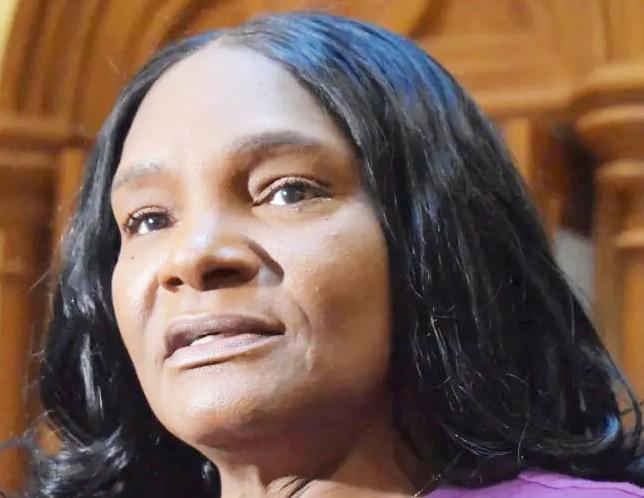
partnering with the Yale School of Architecture, the Yale School of Management, and a Yale Law School Clinic on trying to build up these five properties, likely into two-family homes. “The goal of the land
bank is not to own anything” for the long term, she said, but instead to get “them back on the market.”
She said that the land bank is currently working with the city corporation coun-
sel’s office to finalize all the paperwork required to formally transfer ownership of these five lots from the city to the land bank nonprofit. Her hope is that the land bank will take ownership of these properties this week or next week.
Included in the package of documents submitted to the alders as part of this now-approved property transfer are minutes from a December 2023 meeting of the city’s Property Acquisition and Disposition (PAD) committee.
Those minutes show that the committee voted unanimously in support of transferring these lots to the land bank for $1 apiece after hearing from city economic development staffer Dean Mack about how the land bank “will work in parallel with the City to achieve goals of home ownership, affordable housing, and community development.” Then-city Property Acquisition and Disposition Coordinator Evan Trachten also told the committed that, while LCI “will continue to buy and sell properties,” the land bank will complement that work “in the open market and will be able to purchase properties much faster than the City’s acquisition process.”
Lucy Gellman
Maybe it's the eyes that bring a viewer in, soft and gentle as they look over the sidewalk. Or the mouth, parted halfway as if to speak. Maybe it’s a brilliant burst of blue and green, which fills the frame like a halo.
Inside it, a beatific Sylvia Mendez has appeared on Union Street, ready for a conversation. Beneath her, Shirley Chilsolm looks out onto the road, rocking a red-rimmed pair of glasses that glow in the sun. Just a few feet away, Huey Newton seems ready to chime in. The words of Thurgood Marshall hang between them, a bridge.
Those figures, all underrepresented in American history, now adorn three lunettes outside of High School in the Community, where public art has joined a larger effort to bring history to life. Rooted in both social justice and efforts to beautify the school, they are a collaboration between students in Ben Scudder’s Black & Latino History elective and Yalies Johan Zongo and Katelyn Wang of Bright Spaces, a public art collaborative at Yale’s Dwight Hall.
In the finished piece, Mendez, Chisholm and Newton are all represented in portraiture; the late U.S. Supreme Court Justice Thurgood Marshall is represented with a quote.
“I always would walk by here and they just seemed so empty,” said HSC senior Japhet Gonzalez at a ribbon cutting Friday morning, motioning to the now-vibrant images behind him. “Most of our school is Black and Hispanic. This representation is very important to have outside of our school.”
The murals, which fill three boarded-up, painted-over lunettes near the corner of Union and Water Streets, grew out of a class project in Scudder’s class last year, during which students weighed in on who they wished to see depicted on the wall. There were, initially, many contenders: astronaut Mae Jemison, rapper Tupac Shakur, U.S. Rep. and civil rights icon John Lewis, abolitionist and orator Frederick Douglass and Bayard Rustin among others. Each student had to advocate for their pick, making the project another opportunity to dive into history.
After students voted, four figures remained: Sylvia Mendez, whose fight for civil rights began in California’s elementary schools when she was just a kid; U.S. Rep. Shirley Chisholm, who was the first Black woman in Congress; Thurgood Marshall, a trailblazing civil rights lawyer who was the first Black justice at the Supreme Court of the United States (SCOTUS), and Black Panther Party leader Huey P. Newton, whose history is intertwined with New Haven’s. Between them are shared histories of migration, both voluntary and forced; of activism that was met with vitriol and sometimes violence; of holding one’s heritage close, often at the risk of personal and professional safety. Mendez, for in-
stance, was just a girl when her parents, who were Mexican and Puerto Rican, challenged the Westminster School District after it turned their children away from a largely white school.
For her, it catalyzed a life dedicated to social justice, for which Barack Obama awarded her the Presidential Medal of Freedom in 2011. Her life is also linked to the landmark court case that followed: Marshall used many of the arguments from the Mendez decision, which was an appellate case, when he argued Brown v. Board of Education before the Supreme Court eight years later. At the time, he was the director of the NAACP’s Legal Defense Fund, a position he held before becoming a judge on the Second Circuit Court of Appeals.
Or Chisholm, who brought both her Blackness and her Bajan and West Indian background with her when she ran successfully for the New York State Assembly, and then for Congress, and later for president of the United States. Raised between Brooklyn and Barbados, she became a fierce advocate for everything from children and families to affordable housing, making a path for those like Barbara Jordan, Maxine Waters, Kamala Harris, Jasmine Crockett and Cori Bush. In the mural, Wang and Zongo have captured that history, with a nod to Chisholm’s legacy in yellows and reds around her immaculate coiffure. Around her beaming face, which floats in a cloud of sunshine-colored paint, are the words: “There is no limit to what we as women can accomplish”—a quote popularized not by Chisholm, but by Michelle Obama decades later. The background vibrates in a shocked, neon blue, just a shade brighter than the New Haven sky.
For many of Scudder’s students, who are Black and Latino, the act of bringing the figures to life has struck a chord. It’s one thing to open a history book and read a few paragraphs about who someone was and what they accomplished during their lifetime, said Gonzalez. It’s entirely another to revisit their story through public art (Scudder’s class has also tried live theater and role playing as a way to boost student engagement).
He remembered a recent day in class, when Scudder entered the school wearing a sign that read “Boycott Grapes,” with the logo of the National Farm Workers Association. All day, he had to explain to people—both students and fellow educators—that it was a reference to the late labor activist César Chávez, who in 1965 led the Delano Grape Strike, the start of a five-year fight for farm workers to unionize.
“It just shows that there is a lack of knowledge around Hispanic icons,” Gonzalez said. That’s true of countless Black figures in American history, too, he later added, pointing to the mural of Newton that sits at the corner of the building, surrounded by orange and red brick.
In that piece, a young Newton looks out from the frame, as if he is scanning the street for passers-by. Buildings, silhouetted in reds and pinks, rise behind him.




A panther leaps forward from the grey of his shirt, more eager than it is menacing. Beside him, and soaring above his head, are the words “The revolution has always been in the hands of the young.” Newton spoke the words from jail in 1968, as the Black Power movement continued outside of prison walls.
Scudder, who is in his sixth year teaching at HSC, was also able to use Newton’s history as a chance to teach students about the Black Panther Party in New Haven, which ran both coalition meetings and its revolutionary Free Breakfast Program in the city from the late 1960s through the early 1970s. This fall, that history seems especially present with the passing of Hill matriarch Ann Boyd, a co-founder of the Hill Parents Association who worked to keep Panther history alive decades after the chapter had dissolved.
“It seems like everything that happens in the U.S. intersects with New Haven,” Scudder said (case and point: National Farm Workers Association co-founder Dolores Huerta spoke in the city in 2022). This year, he’s often reminded of that as he gets a course in New Haven history off the ground. After Gonzalez cut the ribbon Friday, he took students over to the side of the building, where a painted-over break in the brick extends from the sidewalk towards the top of the wall. It felt like another potential blank canvas.
“I’d probably want to see something with law or social justice,” since HSC is New Haven’s “social justice” magnet high school, said senior Taylor Hargreaves, who loves the school’s small, tight-knit feel. Born and raised in the city’s Newhallville neighborhood, she’s very influenced by the Black Lives Matter movement, she said. “Like a whole lot of fists in the air.”
Diana Paola Robles Manso, who is currently working on a class project about the feminist writer Gloria Anzaldúa for Hispanic Heritage Month, emphasized the importance of having a figure or moment who could speak to students through art. Before the mural project, for instance, she had heard of Chisholm, “but I didn’t get a deeper understanding of the history until I saw it in my face,” she said.
Building Leader (that’s a fancy word for principal) Nick Perrone, who arrived at HSC earlier this year after several August transfers at the New Haven Board of Education, said he’s excited for the new murals, and hopeful that there will be more to come. Just as murals have beautified the inside of the school in recent years, this makes HSC—which is an old building, where the toll of time is sometimes visible—more welcoming for current and future students and staff.
“It’s so exciting to be a part of it,” he said. “In many ways, each of us is an empty space waiting to be filled with something. It’s beautiful that they took these empty spaces” and used them as a chance to make history come alive.
Wang, who is now working with students at Celentano School, had echoed that praise earlier in the day. “This is just a celebration,” she said.
by Jamil Ragland October
HARTFORD, CT — The Department of Social Services is working to increase its staffing to handle new requirements and potential Medicaid changes, according to Deputy Commissioner Peter Hadler. Hadler told the Medical Assistance Program Oversight Council (MAPOC) about the department’s early plans to mitigate rising costs and staffing needs as a result of changes to food and medical assistance in the federal budget.
“There’s no community that will not be impacted by this,” Hadler said.
The implementation of Medicaid work requires means the department will have to process more frequent eligibility certifications, which will cost millions of dollars. The department is already increasing staffing to handle the new requirements, and is now focused on the Supplemental Nutritional Assistance Program (SNAP) and helping clients meet the changes to work requirements for that benefit. The department is also studying its data to identify clients who may be exempt from work requirements for Medicaid. Hadler said the best case outcome would be to leverage data that DSS already has
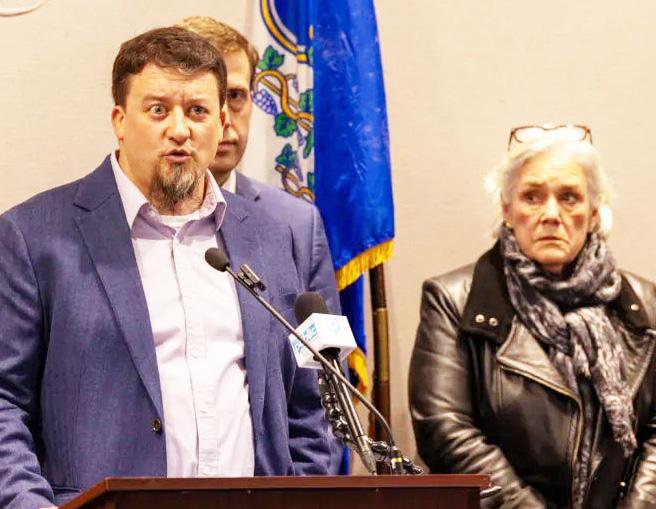
to identify people who do not need to go through additional steps to confirm their eligibility for Husky Part D.
One area the state is focusing on is the use of technology to improve the speed and ease of communicating with clients,
as the department prepares for increased volumes of recertifications and questions and concerns from residents.
Easha Canada, deputy commissioner and chief strategy officer at DSS, detailed some of the improvements the department
has made in recent years, including a virtual hold option to allow the department to call clients back, improvements to its website and document upload features, and expanding use of text messaging for annual renewals and document verification reminders to ensure clients get their information in on time. The department also recently unveiled a new chatbot, named Laurel, which can assist clients with routine questions and help them check their accounts, she said.
Canada also described a new interactive voice response (IVR) system that the department is scheduled to roll out during the fourth quarter of 2025. The system is designed to be a robust, 24-7 self-service option for residents to obtain benefit status and other general inquiries, she said.
Canada said full rollout of the IVR system will take three or four months, and be completed in early 2026.
Despite the continually shifting federal landscape, state Rep. Anne Hughes, D-Easton, expressed optimism about the state’s role in protecting clients.
“I have tremendous faith that we can meet this challenge,” she said. “It is very daunting, and yet we can meet the challenge with the right support and the right resources.”
by Maya McFadden
While most violent crime stats are down, Victim Services Officer Nikki Curry sees on a daily basis that the city is caught in a “generational cycle” of loss and pain that numbers alone don’t capture.
Curry shared that perspective with top cops from New Haven (and Poland) during the city police department’s latest crime-data-focused CompStat meeting, which was held on Thursday at City Hall. The CompStat data showed that, through the week ending Sept. 28, the city had seen 14 homicides so far this year, compared to 8 by this time last year. The data also showed that New Haven had seen 27 nonfatal shooting injuries, compared to 73 at this time last year; 221 burglaries, compared to 372 at this time last year; 556 motor vehicle thefts, compared to 777 at this time last year; and 78 confirmed shots fired, compared to 139 at this time last year.
Thursday’s meeting took place two days before the funeral of Career High School student Kaiden Phillips, who was shot and killed on Sept. 27 in Newhallville. He was the city’s second 15-yearold homicide victim so far this year, following Aaron Robinson’s shooting death in April in the Hill.
Curry described invisible scars passed down through the generations when families are affected by street violence.
“We’re reading all these stats of how crime is down, but we’re burying a 15-year-old this Satur-day,” Curry said. She noted in a Monday interview that
trauma continues years later for families. Rather than hun-dreds of teenagers, teachers, and coaches being able to enjoy Saturday’s warm weather, she said, they gathered at Kaiden’s funeral to mourn his death. “It’s never one and done,” she said.
“These victims are more than numbers.”
Curry spoke on Thursday about how Kaiden had lost his father in 2019. She also spoke about the “accidental” shooting death of 8-year-old New Havener Stacey Glasgow in March. She raised con-cerns about how these traumatic situations impact families and the community as a whole.
In her role with the police department’s victim’s services division, Curry helps victims of a variety of crimes, like major assaults, motor vehicle accidents, and robberies and shootings. She said Thursday that she hosted a successful “Survivors of Homicide” meeting through the police de-partment a week before. She said at the meeting she heard from Hillhouse teens who opened up about their pain of grieving family members who have died by homicide.
“How many caskets and funerals this year of teenagers that we had to go to?”
Curry asked.
Curry went on to speak about a September burglary at Friends Mini Market in Fair Haven where three young people were taken in by police for stealing vapes and money from the store clerk. Cur-ry said two of the three alleged perpetrators were brothers who have three other brothers in the criminal justice system.
“In a lot of these reports that I’m reading with the victims, a lot of them start

off missing school,” Curry said. “Reported missing person, run away from home. [They] start stealing cars, motor vehi-cle thefts. Then it goes up to burglary, then robbery, then assault, and a lot of them come from gen-erations where their fathers are dead, their siblings are murdered, or they’re coming from the of-fenders.”
After Curry’s report Thursday, Police Chief Karl Jacobson said, “We do understand the logistics of ‘Yes, even though violent crime is down, we have lost some teenagers,’ and we’re working very hard with all our partners from Youth Connect, to Project Longevity, to CTVIP. That’s

John P. Thomas Publisher / CEO
Babz Rawls Ivy Editor-in-Chief Liaison, Corporate Affairs Babz@penfieldcomm.com
Advertising/Sales Team
Keith Jackson Delores Alleyne
John Thomas, III
Editorial Team
Staff Writers
Christian Lewis/Current Affairs
Anthony Scott/Sports Arlene Davis-Rudd/Politics
David Asbery / Tanisha Asbery
Jerry Craft / Cartoons / Barbara Fair Dr. Tamiko Jackson-McArthur
Michelle Turner / Smita Shrestha William Spivey / Kam Williams Rev. Samuel T. Ross-Lee
why we’re doing things with our officers, SRO’s [school resource officers] go out and talk to all these kids to make it a reality so that the kids realize that there’s no second chances when it comes to gun violence.”
“The Most Depressing Day” Board of Education student representative Abdellah Aly was a classmate of Kaiden’s at Career. In a separate interview with the Independent, he said that he did not know Kaiden, but saw him around school “engaged, and pretty much happy with his surrounding/friend group.”
Aly recalled returning to school last Monday, two days after Kaiden was killed. He described go-ing back to school after Kaiden’s homicide as “the most depressing day that even I have ever seen.”
He continued, “Many students could not hold it in after they found out, many wanted to leave and vent. Some huddled with each other grieving the unfortunate loss that has been endured. So far, Career and Edgewood from what I heard so far was hit the most. I came down to help support the students, faculty came to help, counselors tried to help too. Top officials, officers, and a support dog came as well. Our security was very much heightened that day (Monday). Teachers were also hit badly, they grieved for Kaiden. What has occurred should have never happened, I am not sure how everything was caused. So, in conclusion, it was a very, grieving and depressing day at our schools.” Con’t on page 09
Contributors At-Large
Christine Stuart
www.CTNewsJunkie.com Paul Bass www.newhavenindependent.org
Memberships
National Association of Black Journalist
National Newspapers Publishers Association
Greater New Haven Chamber of Commerce
Greater New Haven Business & Professional Greater New England Minority Supplier Development Council, Inc.
The Inner-City Newspaper is published weekly by Penfield Communications, Inc. from offices located at 50 Fitch Street, 2nd Floor, New Haven, CT 06515. 203-3870354 phone; 203-387-2684 fax. Subscriptions:$260 per year (does not include sales tax for the in State subscriptions). Send name, address, zip code with payment. Postmaster, send address changes to 50 Fitch Street, New Haven, CT 06515. Display ad deadline Friday prior to insertion date at 5:00pm Advertisers are responsible for checking ads for error in publication. Penfield Communications, Inc d.b.a., “The Inner-City Newspaper” , shall not be liable for failure to publish an ad or for typographical errors or errors in publication, except to the extent of the cost of the space in which actual error appeared in the first insertion. The Publisher reserves the right to refuse advertising for any reason and to alter advertising copy or graphics deemed unacceptable for publication. The entire contents of The Inner-City Newspaper are copyright 2012, Penfield Communications, Inc. and no portion may be reproduced by any means without the written permission of the publisher.



by Jordan Allyn
Elizabeth Gonzalez meticulously molds her tortillas. Her process starts with nixtamalization—soaking and cooking the corn in an alkaline solution, washing, rinsing, and repeating. Then she grinds, mixes the corn into a dough, and presses the dough with a tortilladora. This labor, which takes around four hours, is often concealed behind her kitchen walls.
On Thursday, however, the tortillas leapt from the limewater to the limelight as 150 people celebrated Gonzalez and her partner Anabel Hernández for their work at Tortilleria Semilla Co-Op.
On the second floor of Union League Cafe on Chapel Street, CitySeed staff presented “Good Food Awards” to leaders of five local organizations, including to Gonzalez and Hernández. The voting committee, according to CitySeed Executive Director Sarah Miller, sifted through 100 nominations to select people who strengthen the local food system through various forms of leadership.
“A lot of people in food don’t ever get recognized,” said Miller, who is also the alder for Fair Haven’s Ward 14. “And so we thought it would be a good thing to do to elevate people who are often unappreciated.”
“It’s been a rough year to run a nonprofit,” Miller added. In March, CitySeed lost a $1 million Congressionally Directed Spending grant. They had planned to use the money to support their new building and commercial kitchen in Fair Haven. The nonprofit contributes to New Haven’s food scene by running farmers markets, training culinary professionals, and incubating new businesses. Part of the proceeds from the Good Food Awards will go towards subsidizing the buildout of the nonprofit’s new home on James Street. The rest of the proceeds will support the Sanctuary Kitchen culinary training program and doubling public benefits at the farmers markets.
For Miller, Thursday’s event was “an opportunity to really look at the whole system as one and try to think about how we, these different people who all wear different hats and do different things during the day, collaborate to really make food available to all of us.”
Ten years ago, Meg Fama—another awardee—parked her food truck at a CitySeed farmers market. Fellow farmer and award winner Steve Munno met Fama through the farmers market circuit. “Getting a breakfast sandwich from Meg was the key thing to making the market happen,” said Munno, the executive director of Massaro Community Farm. Before the award ceremony, Fama spent the day prepping squashs (acorn, butternut, and delicata) for her Fair Haven cafe, The Farm Belly. Munno spent the afternoon harvesting cabbage, driving the tractor, and sending emails. “When you’re doing the kind of work we do, in farming and in food, a lot of it is focused on your day-to-day operation,” said Mun-
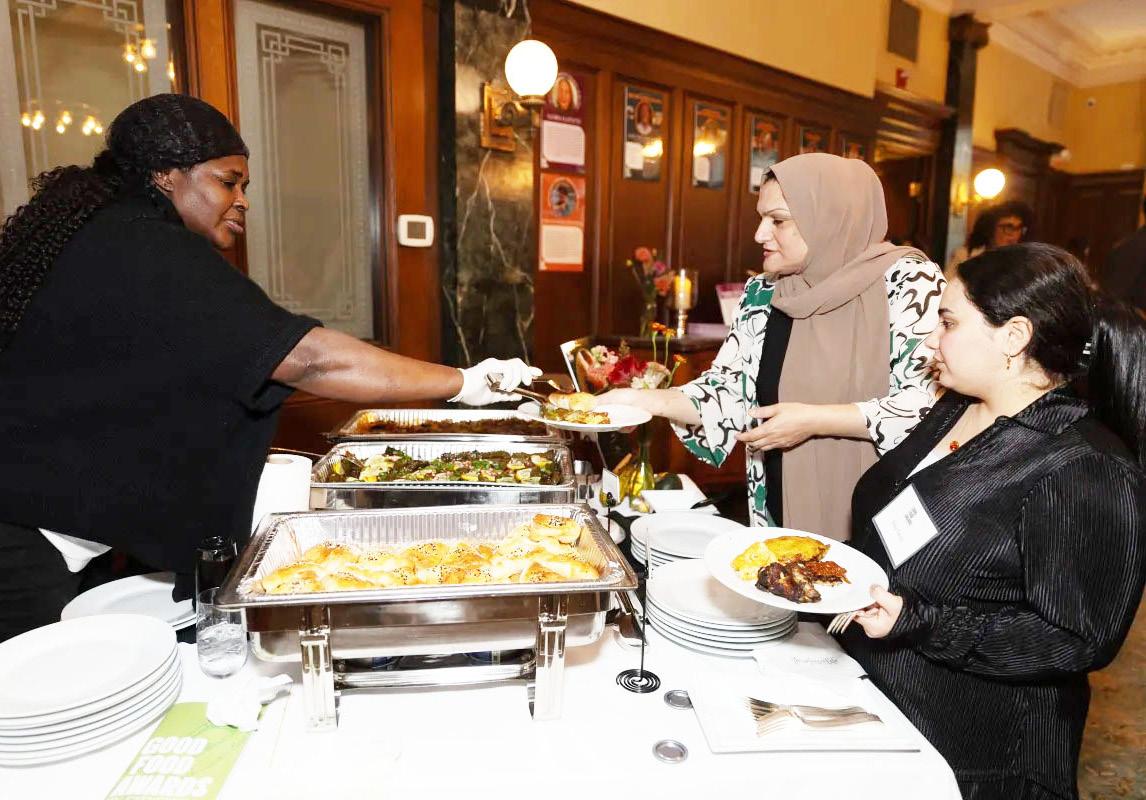
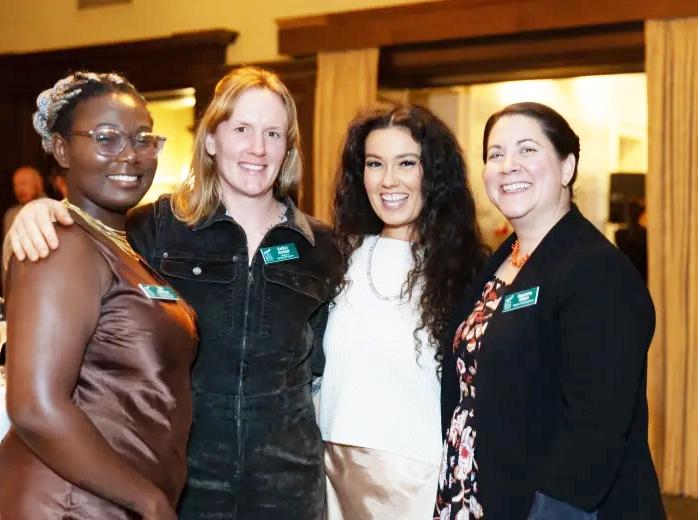
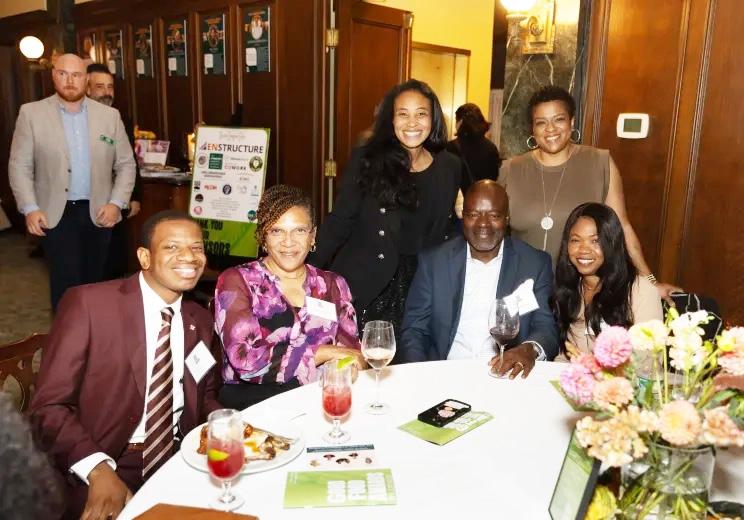
no. “And it can be hard to step away for a moment and appreciate the work that you do and the community that you do it with and amongst.”
Nate Bradshaw, the head of Wilbur Cross High School Culinary Program, and Gideon Gebreyesus, ConnCORP’s Senior Vice President of Hospitality, also won Good Food Awards on Thursday.
“I think that having an award like this serves to remind us and connect us to the leaders in our community who are sometimes hidden,” said Jacqueline Munno, programs manager for International & Professional Experience at the Yale Farm. She added, “You have this amazing taco, but who made the tortilla?”
by Abiba Biao
Instructor Earl McCoy studied his small group of musicians, ripe with potential. None of the singers knew each other, but after two hours of singing together, the sense of an unmistakable bond filled the room. In between the music, laughter and conversation filled the space. He hopes to spark that connection next year at a concert designed to fight against gun violence.
On Thursday, McCoy assembled those five artists to use their voices for change at the first choir rehearsal for an upcoming concert, “Mental Wellness in the Aftermath.” Led by McCoy and held at 310 Orange St., the practice was in preparation for a gun violence memorial. The concert is planned to take place next year on Aug. 22 at the New Haven Botanical Garden of Healing, 105 Valley St.
McCoy’s motivation behind the concert is in remembrance of the 1966 shooting by Arthur James Davis at 16 Northeast Dr. in the Ashmun St. Projects. Looking for his estranged girlfriend Gloria Baskerville, Davis entered her mother’s apartment, belonging to 51-year-old Mary McClease. Enraged from getting no answer about Baskerville, Davis opened fire.
The shooting resulted in six fatalities — including McClease, McCoy’s aunt Carolyn Sykes, and McCoy’s cousin, Michael Sykes (who were 24 and 5, respectively, at their time of death), 27-year-old Richard Leathers, 55-year-old Neil White and 14-year-old Francine McClease.
McCoy was only a year old during the massacre. Next year marks 60 years since the killing.
Carolyn’s sons, 4-year-old Troy Sykes and 6-year-old Maurice “Butch” Sykes Jr., survived the shooting and later moved in with McCoy and his family. Despite them being cousins, McCoy said their relationship was more of a brotherly bond, describing Maurice as “the closest thing to a Black superhero I’ve ever seen.” Troy, he said, was a “guardian angel,” always extending a helping hand.
Despite the years removed from the incident, the trauma would have lasting repercussions on the family. When McCoy entered his freshman year at James Hillhouse High School, Troy, then a senior, would playfully punch McCoy in the hallways and ask if anyone was bullying him. Little did he know that these would be some of the last memories McCoy would have of Troy before he committed suicide in 1981 at just 19 years old.
During a visit to the Botanical Garden of Healing in 2021 with his wife and son, McCoy said he felt a calling.
“While I was there, I felt something tug on my pants, but there was nothing there,” he said, “and I swore to this day I heard a voice saying, ‘We belong here,’ and ‘we’ meaning my Aunt Carolyn, Michael, and Troy.”
McCoy stayed true to this vision and
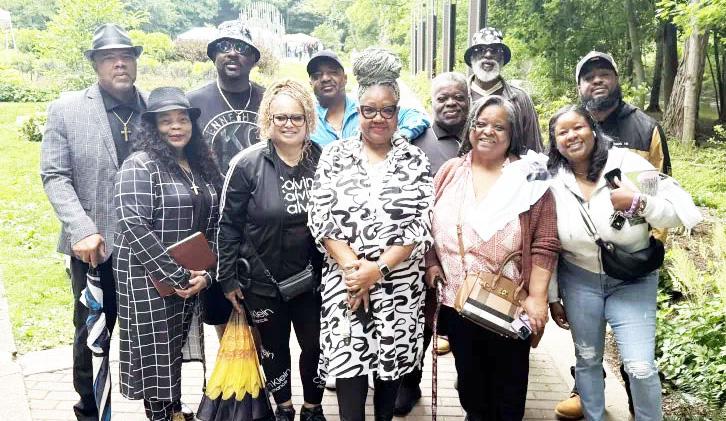
his efforts ended up being successful.
In June, McCoy and his family laid six bricks for each of the 1966 victims on the botanical garden’s pathways, during the fourth annual memorial ceremony for victims of gun violence.
“They’re missed deeply by me … I wish I had the opportunity to grow up with my cousin Michael and Aunt Carolyn,” he said, reflecting on his journey with grief and how he is still navigating through the aftereffects of trauma.
The biggest lesson he hopes people take away from the concert is an inspiration to learn “how to deal with conflict resolution” and implementing de-escalation strategies.
McCoy took note of a theme of care, and tried to encapsulate this message into the lineup of songs. Each person at Thursday’s rehearsal received printed out lyrics of “We Are The World,” written by Michael Jackson and Lionel Richie; “America the Beautiful,” by Ray Charles; “That’s What Friends are For,” by Dionne Warwick; and Michael Jackson’s “Heal the World.”
The singers were all friends of McCoy, disseminating information about the event through word of mouth. Now, he hopes to widen his net and obtain more singers by hosting monthly rehearsals.
The group chose to tackle “We Are The World” first, a 1985 charity single which featured 46 artists to raise money for famine relief in Africa.
Lisa Richitelli was tasked with embodying her inner Cyndi Lauper, covering the ad-libs and bridge of the song. But, on the first try, her voice didn’t fill the energy needed for the bridge. It was then that Queen Yarri jumped in to the rescue. “We gonna do this together,” Yarri said, turning to Richitelli. “Come on, me and you. One, two, three, hit it,” and the two launched into singing, “Let us realize.”
“Don’t bring your voice down. Keep your voice up with me,” Yarri said, show-


ing Richitelli step by step, showing the movements of her mouth to engage in syllabic singing.
It was then after a couple more attempts
derlying tone.
Sitting in the front row were Gwen McCrea and Cheryl Corey, who each took parts of the chorus. The only man in the group, Joe Marini, was assigned to take up Bob Dylan’s part, a noticeable feature on the track due to his nasally tone and vocal breaks.
Following each performance, Yarri recorded the audio on her phone and played it back for everyone else to hear. After a few runs with the karaoke version, markups and lyric revisions in pen, a clear pattern emerged from the singers. As the night continued, each of the members fell into their roles, complementing one another with increasing precision.
In the end, the participants attributed one thing that compelled them to join the concert: McCoy and his passion.
“I’m gonna go out on a limb just because it’s Earl and that’s all the reason why I do it,” Marini said. “Literally three quarters of the things that I do outside of my own little world is cause of him.”
The group stressed community involvement in children’s upbringing as an effective intervention for preventing violence. McCrea referenced her days of living with a “neighborhood Ma,” and watchfulness of neighbors of kids, to which the others agreed and shared their own anecdotes. They also cited the difference in parenting styles across generations, saying that there is a rise in “latch-key kids” and that children nowadays don’t have close mentor figures or live in a dysfunctional household. They said that these influences can hamper their social skills.
“Some of them just go home and there’s no one there to guide them,” McCrea said. “And no social interactions because of their phones,” Marini added.
Another factor the group attributed to the uptick of youth violence was lack of discipline from parents. Yarri outlined the impact of vicarious trauma on residents, referencing the recent murder of 15-year-old Kaiden Phillips allegedly by a 13-year-old.
“These violent crimes, they disturb the community. It’s not okay. And it bothers our mental health to hear something like that. It’s just like –” she paused to collect her words. “Like, I don’t even have words for it — unacceptable behavior!”
Similar to McCoy, gun violence is also a personal issue for McCrea. With her nephew being memorialized in the Botanical Garden of Healing, she said she hopes the concert can help others dealing with loss.
“I just want to see everybody just come together… because there’s going to be a lot of people out there that need to be comforted,” she said.
that Richitelli was able to stabilize her voice to a higher pitch. The result was melodious, with Richitelli complementing Yarri’s lively voice with a steady, un-
The next rehearsal will take place on Friday, Nov. 14 at 310 Orange St. Positions for singers and event sponsors are still open. If interested, contact Earl McCoy at Fatherhood.RealMen.RealTalk@ gmail.com
by Allan Appel
When Lee High School history teacher
Linda Powell nervously called her union longshoreman father from jail that day in 1975, he applauded her, saying, “You stay there as long as you have to. You did the right thing.”
But years later at all those parent-teacher nights when Powell visited her own child’s middle school, he remembered how upset he got because no matter what the circumstances, no matter how right her son thought he was, his mom always but always took the side of the teachers. Thursday afternoon those kinds of memories — personal, familial, political, and historical — were at the center of a spirited commemorative gathering of some 75 now-retired New Haven teachers who walked picket lines or were jailed in the historic two-week New Haven teachers strike that began on Nov. 8, 1975.
The year of commemorative events partnering with the New Haven Federation of Teachers Local 933 (Retired), chaired by Nancy Charest, was organized by Dr. Pamela Monk-Kelley, who is now in her 49th year of teaching in the city’s public school system.
About a dozen of the leaders in the core group of 90 who were jailed in facilities across the state were in attendance at the Carmen di Vega Restaurant on upper Whalley Avenue, along with other strikers, picketers, friends, family, and supporters. They gathered to check out old photographs, to reminisce, and to lend their ideas and support to the current teachers union contract negotiations that are now under way.
Although many were no longer as spry as they had been in front of a classroom, they still demonstrated their “teacher voice” in loudly applauding Dario Sulzman, a current Wilbur Cross High School teacher, as he brought them up to

speed on the focal points of current contract negotiation demands of the union: Reduction in class sizes, better facilities for both students and teachers — he referenced ceiling tiles falling down in various locations at his school — and salary raises that do more than barely cover, if are not completely washed away by, the increased costs for health care premiums.
Dr. Marc Blosveren, who was supervisor of science for the district from 1989
to 2004, called out, “What’s the current class size?”
When Sulzman answered that he thought it 27 students, at the high school level, Blosveren recalled that on his first day in front of a class, in 1969, he was facing –count em — 38 students! In the early 1970s two much smaller union strikes, in which just a handful were jailed, reduced class size, Blosveren recalled, first to 35, then to 30. And the historic strike of 1975
brought that number down to 27, where it remains today.
Although public employees such as teachers are still now not able legally to strike, the historic nature of the 1975 strike, which drew broad local community and then massive statewide organized labor support, in essence made the union an equal partner in negotiations, former teachers union President Frank Carrano recalled.
Why did Powell take the risk of walking out and going to jail?
There was, she recalled, of course, the influence of the union household in which she grew up. But there was more: “I grew up with Vietnam, civil rights, and the women’s movement in the 60s. To participate was natural for me.”
Still, going to jail (she was sent to Camp Hartell, a National Guard facility, in Windsor Locks) was serious business for Powell, who had just started her career.
“Jail was a real watershed for me. But you wanted to be a good example for the students. When they asked why, I said, we’re fighting for smaller class size, more support. Sometimes you have to break the law to change the law.”
“The ‘New Haven 90’ in 1975 made some good trouble,” said Charest, as Thursday’s meal wound down and she called on all the jailed teachers to stand, to enthusiastic applause.
Then she asked the other strikers to stand. Then those who walked the picket line to stand. “The current union stands on the shoulders of these giants. This was very much an historical event.”
Before lunch concluded and perhaps taking a page from 1975, Sulzman announced, “We’re trying to have not just a negotiation but a campaign, like a rally.”
He announced that the first installment of the campaign will take place on Oct. 27
by Paul Bass
Terence Shard, who went by “ThreeFifths” in his role as an outspoken commenter on local politics, died Oct. 3 at Yale New Haven Hospital after battling a long illness. He was 70 years old.
Shard’s prolific critiques of upscale development and political corruption in the comments section of the New Haven Independent had a wide following and made phrases like “gentrification vampires” and “crooked two-party system” into terms of art in the city’s political discourse (not to mention “Wake up and smell the mackerel!” and “Vote Teletubbies!”). Along with the late Rebecca Turcio (aka “Cedar Hill Resident”), Shard was the most prolific and widely read daily commenter in the Independent’s first decade, establishing the section as a fundamental part of the
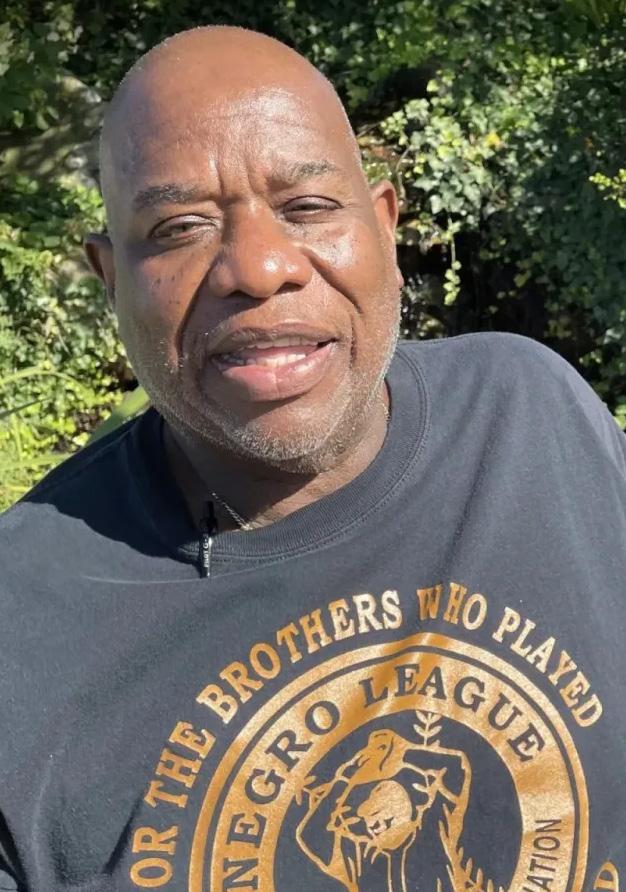
news cycle that elevated the voices of citizens.
His decision to identify as Three-Fifths served as a reminder of the country’s founding calculation of every five slaves as three people for determining taxes and legislative districts.
The grandson of a rabbi, Shard was a proud vegan, Buddhist, and Black nationalist. He was always eager to engage in spirited debate, with a smile, including in random encounters at the Edge of the Woods natural grocery store, where references to fast-food restaurants “McDeath” and “Murder King” could be heard an aisle away as he gradually steered his cart past the fruits and greens. He enjoyed the pleased looks on the faces of strangers when they realized, “You’re ThreeFifths!” He regularly shared inside info he picked up from grassroots contacts in the city and offered detailed historical context
by Paul Bass
Frances “Bitsie” Clark, the gravel-voiced open-hearted people person and unshakeable optimist who led New Haven’s late 20th century cultural revival and the development of the Audubon Arts District, died Friday surrounded by loved ones in her apartment at the Whitney Center retirement community.
She was three weeks shy of her 95th birthday. She died of natural causes.
Clark leaves behind a city’s worth of artists and decision-makers and dreamers who benefited from her guidance, counsel, and indefatigable optimism. Many of them stopped by her room in the past month to say good-bye as the end neared. The day before she died she rewatched her favorite movie, Blazing Saddles, with her close friend Maryann Ott, quoting her favorite lines.
“She was always more enthusiastic about what you were doing than you were,” people repeatedly told her daughter, Mary Vines.
Mary Frances “Bitsie” Thompson was born on Oct. 30, 1931. She grew up in the Bay Ridge section of Brooklyn. She attended the Berkeley Institute for Girls (now the Berkeley Carroll School), where as junior class president she was invited to a gathering of fellow school officers hosted by Eleanor Roosevelt. Roosevelt told the assembled teens they had been chosen to pursue leadership roles so they would not leave “politics to the hacks,” daughter Mary recalled. Frances decided she would become the nation’s first female president.
She brought that goal to Vassar College. She enrolled in political science courses. An adviser insisted she take art and music courses in order to be a “well-rounded” president. She discovered she loved the arts, too.
In 1954 she married John Phelps Clark. The couple raised a family in Branford. Bitsie later moved to New Haven after the couple divorced.
for modern-day political observations.
Shard was born in Brooklyn, N.Y., to Gloria and Edward Shard. He moved to New Haven in 1994. He retired as a New York State corrections officer, continuing afterwards to work as a radio host on WPKN FM.
“He was an amazing husband. He was an amazing father and stepfather,” said his wife Barbara Shard, who was by his bed when he died. Even in his final days in the hospital he enjoyed connecting with people, she said: “He found out that the man who was sharing the room with him followed the Yankees. They talked through the curtains while watching the game.”
Shard is survived by daughters Kenya Ellerby and the actress and singer Tueree Shard; stepsons Blake Fisher and Corey Fisher; and four grandchildren. A private burial is planned for family.
After honing her managerial skills working for the Girls Scouts of the USA, Clark took the helm of the Arts Council of Greater New Haven in 1983. New Haven was emerging from the post-urban renewal hangover of the 1970s with revival visions built around the city’s combination of grassroots and elite (read: Yale) theatrical, visual arts, and musical chops. Clark remained at the job for the next 19 years, patiently guiding plans to build an arts-centered residential and commercial district on Audubon Street. She got to know — and was able to relate to — every important player on the scene from community theater promoters to politicians to benefactors to academic bigwigs. She negotiated with them, prodded them, hit them up for support, socialized with them, settled their disputes. And laughed with them at every step. She was equally at home in City Hall and the concert hall, Con’t on page
by Lisa Reisman
There were squeals, cheers, frenzied clapping. Some students jumped up and down, hands over their mouths. Others held onto each other. A few dropped to their knees.
That was the scene in the gymnasium of Elm City College Prep Middle School, a public charter school on James Street. The star at this assembly: Joshua McCown, the 22-year-old founder and designer of the Time A Tell clothing brand. It’s been showing up throughout New Haven and across the globe—as well as on the concert stages, music videos, and social media platforms of celebrated rap artists.
The purpose of the assembly this past Friday: to announce a collaboration between Time A Tell and the school, one that will reward academic prowess and solid citizenship with the T-shirts, sweat suits, and varsity jackets jam-packed with color-saturated logos and slogans that distinguish the brand.
“This is about recognizing scholars that are doing the right thing, that are positively impacting our community, that are getting good grades, and making good choices in the classroom,” emcee and Dean of Students Alexandria Blackwood told the 256 students grades five to eight filling the bleachers.
To hear Blackwood tell it, the popularity of the brand among students set the partnership in motion.
“We see so many of our kids wearing Time A Tell, and we wanted to connect things that they love with academics,” she said, as a spirited students versus staff basketball game was winding down and McCown prepared to take the floor.
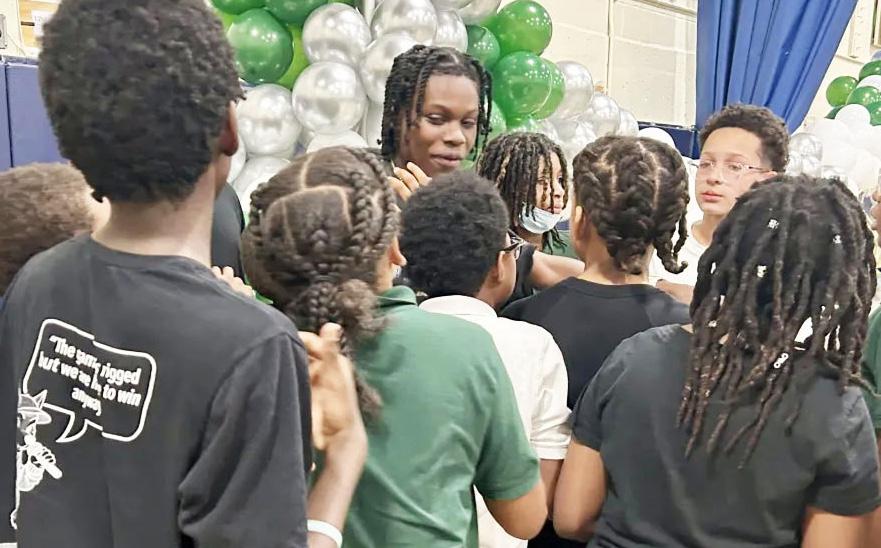
“Then we learned about Josh and we reached out to him, and he was all in.”
With that, she handed the mic to McCown. Clad in Time A Tell (TAT) overalls with one strap casually off the shoulder, he exhibited the sense of style that, soon after graduating from Hamden High, he parlayed into the Time A Tell clothing line.
McCown named the brand for the care and patience required to get something right. A year later, in April 2022, he opened Time A Tell clothing store and smoke shop on Dixwell, drawing inspira-
tion from his girlfriend Nevaeh Dent and father, both business owners.
“Knowledge is power,” McCown told the students, once the screaming died down. “I’m here to tell you that you can do whatever you put your mind to. If I can do it, you can too.”
Standing off to the side, Cleo and James McCown, Josh’s parents, looked on.
“We’re very proud, but not surprised,” Cleo said. “He always had it in him.”
Blackwood invited Dent to join her.
“This young lady standing next to me,
Miss Vae, she owns a beauty supply store, she’s a hairdresser, a hair salon owner, a spa owner, and she runs a beauty academy,” she said, referring to Dent’s LSH Academy, where she schools girls aged 7 to 17 in the beauty care business. “She’s a boss in her own right.”
Watching intently from the floor was seventh-grader Analia. “I love Time A Tell,” she said, holding up a scrap of paper with McCown’s autograph. “I’m gonna put this on my wall.”
“I worked with Josh and Miss Vae to create these exclusive designs, which means only we have it,” Blackwood was
saying, after unveiling the new merch; TIMEATELL x ELM CITY MIDDLE, it read. “Our scholars are going to be repping Time A Tell and Elm City and that means they’re repping perseverance, accountability, knowledge, and maturity.”
She called out the names of students to claim their rewards. Among them was Camille, who said her favorite subject was history. “But I work hard in everything and I get A’s in everything,” she said, as she admired her new T shirt.
Outside the gymnasium, McCown and Dent led an impromptu career counseling session. Dent said she opened her first business when she was 17, and McCown followed at 20. “One thing we always did was focus,” she said, amid the beat of a hip hop track from a dance competition inside. “Josh is where he’s at because every single day he works at his craft, but it starts at school.”
“You gotta finish school and you gotta put your heart into everything you do,” McCown said. “When I make my clothes, I wanna say ‘yeah, I want that,’ like I’m on the outside looking in.”
“Josh is not trying to copy other designers, he’s creating his own way,” Dent rejoined. “And that’s what you guys need to do, figure out what you enjoy doing because that means you’re probably good at it, and then get to work. When we come back here, we’ll be checking up on you.”
Nearby was Principal Leisel Renaud. “A collaboration like this is important because we can recognize our scholars and also show all our students there are so many ways to succeed,” Renaud said, gesturing at McCown and Dent. “This is the beginning of something important and special.”
by Paul Bass
Hundreds of New Haveners may end up with lower energy bills thanks to a $50,000 grant New Haven is receiving. The grant comes from Energize CT, a state government-utility consortium that promotes green-energy programs.
New Haven’s government was one of 17 recipients of “community partnership” grants announced Thursday. The grants help communities reach out to people to take advantage of home and office energy assessments (how to caulk and re-window and otherwise insulate your building to require less heat or A/C) and of programs to switch from oil burning to geothermal heat pumps.
City Climate & Sustainability Director Steve Winter said his office plans to use the money to pay for referrals from Community Action Agency and Operation Fuel of
families that can qualify and benefit from the programs; to work with New England Smart Energy to help people upgrade to heat pumps; and to pay for mailers and events to inform people of the programs. Winter said the goal is to connect with at least 200 referred people.
The grants go in some communities to nonprofits that do on-the-ground outreach green-energy work. New Haven has an office (Winter’s) that does the work as well.
“The city of New Haven, with its sustainability department, is definitely ahead of the curve and is really thinking about about these issues,” Marissa Westbrook, a UI employee who manages conservation programs for the Energize CT alliance, said during a conversation Thursday on WNHH FM’s “Dateline New Haven.”
She noted that ratepayers pay for Energize CT’s programs through a “system benefits charge” mandated by state gov-

ernment.
Westbrook appeared on “Dateline” with Ian Johnson, a 2025 high school grad who now works full-time in HVAC installation and maintenance. Johnson got started on the path to gaining his certification in part of an Energize CT program called Green STEP (Sustainability Technical Education Program). Green STEP is aimed at keeping the state’s 46,000-member green energy workforce filled and trained in order to carry out efforts to combat climate change and save people money on their bills.
“I love the job,” Johnson said of installing and cleaning out furances, changing nozzles and pumps and filters. “Every time my alarm goes off, it’s funny, I actually have energy. I get excited. I love using my brain. Which wires go where … How do I make these pipes fit in the spot that I need to at the right length and make it all look nice?”
by Mona Mahadevan
Tenants of a subsidized Quinnipiac Meadows complex will soon get to decide which union if any represents them — one endorsed by management or one backed by the Connecticut Tenants Union (CTTU).
They’ll be able to make that choice when CTTU-backed union members ask their fellow residents to sign union cards. The start of the card-signing process was announced during a press conference Thursday afternoon, held across from Sunset Ridge Apartments at 17 Mountain Ridge Ter. Mayor Justin Elicker, Quinnipiac Meadows/Bishop Woods Alder Theresa Morant, and dozens of CTTU organizers and allies stood with Sunset Ridge tenants as they recounted their experiences with untreated mold, persistent rodent infestations, and excessive rent hikes.
The owner of the 312-unit complex, the New York-based Capital Realty Group, is facing seven unions newly formed across five states, a nationwide organizing effort that began in New Haven’s Park Ridge Apartments. At Sunset Ridge, residents have long complained about unjust and unhealthy living conditions. More recently, the landlord has been accused of retaliation tactics by towing tenants’ and organizers’ cars, following around residents, banning CTTU leaders from the property, and creating a management-backed union. (The president of that union has insisted that it is real.)
During Thursday’s press conference, tenants called on Capital Realty to address the health and safety issues that they say they’ve been experiencing for years. April Hedge, who’s lived in the property for 21 years, said she started seeing mice only after Capital Realty bought the complex in July 2023. She claimed that flooding was a weekly occurrence
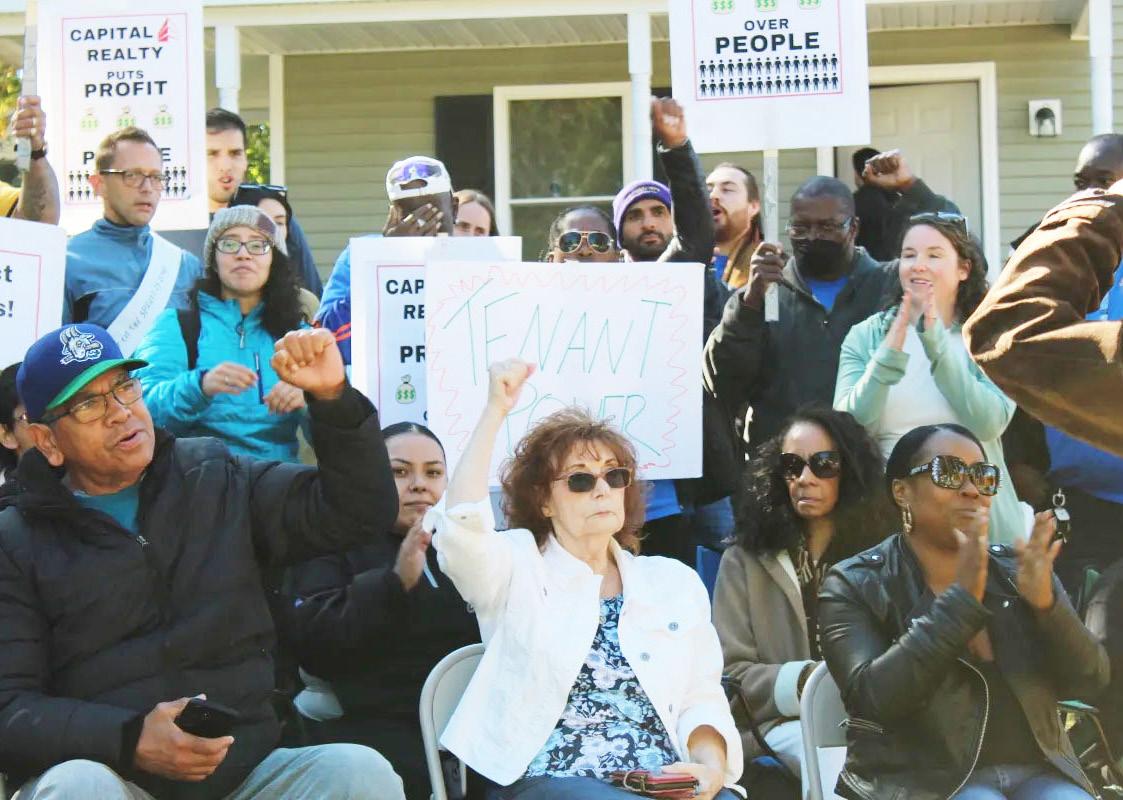
for her elderly mom, who lived in one of the complex’s basement units. After she complained, she recalled a maintenance worker asking, “Why doesn’t she move?”
Juan Garcia, another longtime Sunset Ridge resident, said he had also been told to pull his daughter out of school and move.
“They don’t want to fix nothing,” said Garcia, who added that his rent’s been raised “higher and higher” since Capital Realty took over.
After the press conference, Cynthia
Vega Vieyra told the Independent how overcoming a bad accident led her to finally contact the Fair Rent Commission (FRC), Livable City Initiative (LCI), and CTTU.
She moved into the complex seven years ago with her now ex-husband, who she said used to clean the unit’s mold and handle other maintenance issues. When he moved out, she had to start relying on the building’s maintenance workers to fix problems in her apartment. But, she said, they’d take weeks to respond and often
perform “garbage” work.
She said that in 2023, she vacationed with her mother in her home country, Mexico, and experienced a severe medical episode that took over four months of recovery.
“That made me realize that I have so much more to do in my life,” said Vega Vieyra.
When she returned, she felt empowered to reach out to LCI, FRC, and CTTU for help on with a persistent leak, mold in her bathroom and closet, and a sudden rent
increase from $1,133 to $1,450. She said FRC lowered her rent to $1,245, which is “still a lot” but more manageable.
Vega Vieyra’s experience with mold and mice is common across the building, said Elicker. He said that this year alone, LCI has received 38 complaints about the building, some of which they’re still pushing on management to address. “Capital Realty, what are you doing?” Elicker asked. He called on management to stop “intimidating” and “threatening” people who’ve been invited by tenants to the property.
The president of the current, management-backed union, Sebastian Gomez, has insisted that it’s real and succeeding in pushing the owner to make improvements to the property.
Melonakos has pushed back, saying that at least one member of the purported union is a member of Capital Realty Staff. There’s a “discrepancy between supporting one group and clamping down with people who want to organize with us,” he said. He disagreed with the concept of a management-backed union, arguing that a fair bargaining process requires management to not have discretion over what a union does and says. He also pointed out that the union’s board is unelected, making it less “democratic” than a CTTU-backed union.
After Thursday’s press conference, the Independent spoke to five random tenants about the two unions. Three of them said they hadn’t heard of either union, and two called the management-backed union “fake.” Two of the people who hadn’t heard of either union both said they enjoyed the complex. One said living there has been “a good experience, relaxed and quiet.” But the two people who called the management-backed union fake are both considering joining the CTTU-backed union.
by Donald Eng
WEST HARTFORD, CT — As a fall chill settled over much of Connecticut this week, Gov. Ned Lamont and the state Department of Housing released $8 million to help people experiencing homelessness stay warm and find homes this upcoming winter.
State officials and housing advocates gathered at the Journey Home free furniture bank on New Park Avenue in West Hartford to announce two funding initiatives. The Connecticut Department of Housing (DOH) is awarding $4.5 million in funding to support cold weather emergency shelter services for the 2025-26 winter season. Additionally, the department is providing $3.5 million to support 14 homeless hubs across the state, which serve as alternative entry points to the state’s coordinated access networks. Along with the 211 phone system, these
physical sites can connect people experiencing homelessness with services and resources to assist them.
“No one in Connecticut should have to sleep outside in freezing temperatures,” said Deputy Housing Commissioner Julian Pierce. “And under this administration, homelessness cannot and will not be a death sentence.”
Pierce said last year cold weather emergency shelter funding helped nearly 5,000 people find refuge from the cold, and that the state had grown its shelter capacity by 574 beds.
The funding comes as Connecticut is grappling with increasing numbers of people experiencing homelessness. According to the most recent Point-in-Time (PIT) count, the number of people experiencing homelessness in January increased by nearly 10% from 2024 to 2025. And

the number of people who were completely unsheltered – sleeping in cars, under bridges or out in the open – rose by 45%.
Matthew Morgan, executive director of Journey Home, said the organization, which coordinates all cold weather programs in the capital region, is “very concerned” about the upcoming winter. The cold can be deadly for those who are unsheltered, he said. One individual last year suffered from frostbite that resulted in him losing both legs, he said.
“With the American Rescue Plan funding expiring that had been funding all of these cold weather programs, we were really worried that without the state stepping up, we would have quite a catastrophe in our hands this winter,” he said. “So we are so relieved and so grateful Connecticut has decided to invest in its people to keep them safe and warm. These are litCon’t on page 15








by Adam Wassilchalk Spunk Yale Repertory Theatre
Through Oct. 25
A tight-knit community forever changed by the arrival of a charming stranger. Gripping romantic triumphs and ruptures. Unbelievable feats of luck, skill, and spirit. These hallmarks of a good tall tale are woven together with a wit, musicality, and fervor that honors Southern Black cultural practice in Spunk. The play is a dramatization of Zora Neale Hurston’s 1935 short story of the same name, uncovered by the Library of Congress in 1997, and produced for the first time ever by Yale Repertory Theatre this season with direction by Tamilla Woodard, choreography by nicHi douglas, and new songs, arrangements and music supervision by Nehemiah Luckett.
Hurston’s script conjures a community, set in central Florida in 1935, where every tongue is sharp with Southern wordsmithing. Words are as powerful and useful as any of the other weapons and tools seen throughout the play, and multiple turns of phrase jolted myself and other members of the audience just as much as the characters those lines were delivered to. Between all the hot gossip, heated confrontations, and steamy confessions of love throughout the show, I found myself admiring Hurston’s fiery pen over and over.
While Spunk is largely promoted as a play, the playbill reveals that a whopping 30 songs feature in each two-hour performance. Many of these are large ensemble numbers, including the showstopping “Sing You Sinners”, which exemplifies my favorite aspect of the piece: each song is integrated seamlessly and naturally into the action and emotion of the play, offering a compelling alternative to the style of the “traditional” musical. Characters seem to catch rhythm and harmony like they’d catch any other spirit, and the catching is infectious.
According to a program note by production dramaturg Eric M. Glover, the surviving text of Spunk features song “titles and scraps of lyrics” without a score, leading the creative team to spend the last four years researching and drawing from “Hurston’s own recordings in the library of congress, old records, internet video, yellowing sheet music, clips of historical performance… and our own community’s collective knowledge” along with Nehemiah Luckett’s own compositions and arrangements to present a score that they believe “is the closest to what Hurston intended.” nicHi douglas’s choreography con-




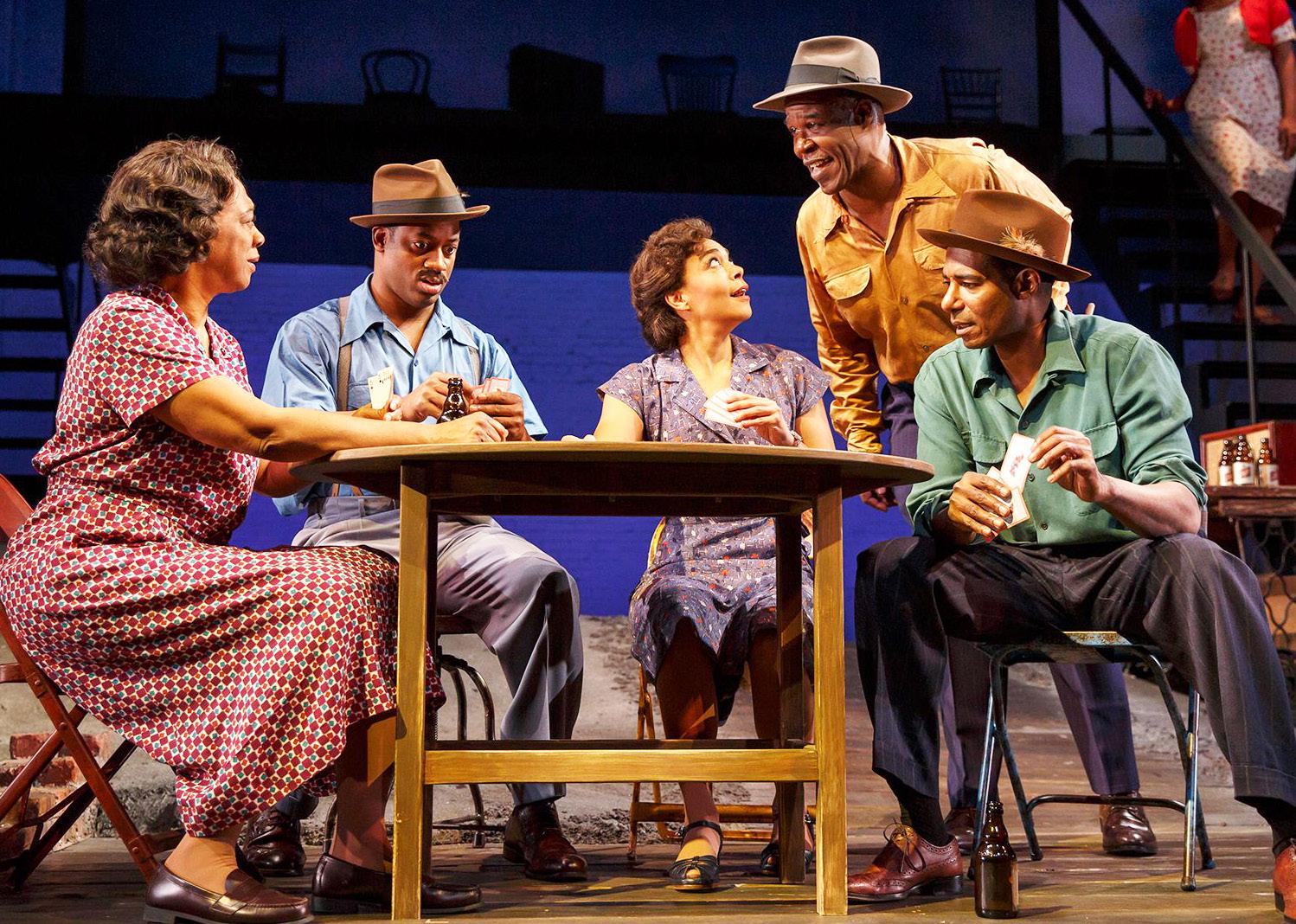
tributes to the gentle spontaneity of Spunk’s music. On top of using their bodies to and voices to express their musical whims, characters transform mundane elements of their environment into playfully percussive accoutrement; “Spoons” and “Washboard” are listed in the musical instruments section of the program, for example. At one point, a signboard is tipped over to become a tap board where performer Alaman Diadhiou shows off his fancy footwork as a character named Blue Trout.
Diadhiou is one of multiple standout performers in the production’s terrific cast, who vibrantly portray a community not unlike Hurston’s own hometown of Eatonville, Florida, under Tamilla Woodard’s dynamic and emotionally captivating direction. J. Quinton Johnson, who plays the titular Spunk, is a corny lover in the best way possible, someone you can’t help but root for to overcome the obstacles in between him and his paramour, the gorgeous and headstrong Evalina, who Kimber Elayna Sprawl portrays with great tenacity and depth. Naiqui Macabroad and Charlie Hudon III make a great pair of antagonists as Jim and Hodge Bishop, respectively, with each carrying the fascinating nuance of wielding hoodoo practice to resist change and maintain a status quo that Spunk disrupts.
Spunk’s designs lean toward simple, no-frills, period- and setting-appropriate gestures that forefront the drama and feel as though they could have been produced similarly in 1935 as they are today. That is, with one significant and wonderful exception; in a scene where a Hoodoo rootwork is invoked against Spunk, the design vocabulary of the production shifts dramatically, thrillingly showcasing the range and talent of scenic designer Karen Loewy Movilla, costume designer Kristen Taylor, lighting designer Gib Gibney, sound designer Justin Ellington, and projection designer Ke Xu 许许. I’m still getting goosebumps thinking about it.
In a speech following the opening night performance, outgoing Yale Rep Artistic Director James Bundy gave a shoutout to their resident dramaturg Catherine Sheehy, who has been advocating for Spunk to be read, seen, and produced at Yale Rep and elsewhere ever since the Library of Congress first notified her of its existence over 20 years ago.
While Hurston is better known to most as a novelist and anthropologist, Yale Rep’s long-awaited production of Spunk makes a great case for her as one of the finest musical theater practitioners in history, as well as for Luckett, douglas, and Woodard as some of the finest musical theater practitioners working today.















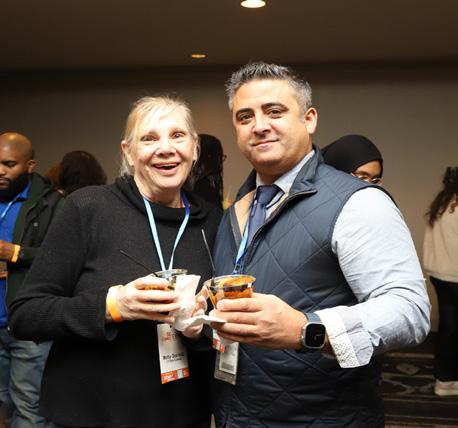














Invincible: A Glorious Tribute to Michael Jackson Sat, Sep 27, 8 pm ($35-45)
Take Me As I Am: A Joni Mitchell Tribute with Rainee Blake Sat, Oct 4, 8 pm ($30)
Cedric Burnside
GRAMMY-Winning Blues Artist Thu, Oct 9, 7:30 pm ($45)
Disney’s: Moana
Live-to-Film Concert
6 pm Pre-Show Activities Fri, Oct 10, 7 pm ($20-25)
Ray Chen*
Julio Elizalde, Piano Fri, Oct 17, 8 pm ($35-40)
An Evening with Jacob Collier
The Djesse Solo Show Sat, Oct 18, 8 pm ($45-65)
Compagnie Hervé Koubi Sol Invictus Thu, Oct 23, 7:30 pm ($35-40) & MORE!
*Lenard Chamber Music Series

860-486-4226 | @JorgensenUConn On the UConn Storrs campus


by Thomas Breen
The New Haven independent
Masked revelers raised $32,500 to help keep Dixwell’s community center alive and thriving, at a Q House “fall ball” that also honored city public school leaders.
That ball took place at the Q House at 197 Dixwell Ave. on Sept. 19. The event had a “masquerade theme” that, according to promotional material for the ball, sought to blend “elegance with pur-pose.”
Jeanette Morrison, a long-time Dixwell alder and chair of the Q House Advisory Board, said that roughly 150 people turned out to celebrate the revived community center and to fête honorees Ker-mit Carolina, Sondi Jackson, David Diah, and the late Dr. Fred Smith, aka Mr. Freddy Fixer.
“The honorees represent members of the New Haven Public Schools and the relationship be-tween education and community and its success,” Morrison told the Independent.
She said this first annual Q House Fall Ball harkens back to similar events that a previous version of the Q House used to hold in the 1970s and 1980s. Morrison said that a total of $32,500 was raised to support the Q House’s endowment fund.
“In 1924, the Dixwell Q House first opened its doors as a settlement house, providing a vital space of refuge, connection, and advancement for African American families arriving in New Haven dur-ing the Great Migration,” reads a sponsorship proposal for the Sept. 19 ball. “One hundred and one years later, the Q House continues to serve as a vibrant and essential hub in the Dixwell and Newhallville neighborhoods.
“Throughout the decades, the Q House has grown to become a center for youth empowerment, family wellness, cultural celebration, and community transformation. With more than 70 classes, workshops, and events offered weekly—serving youth, adults, and seniors—the Q House is a thriving example of community-led strength and care.”
Con’t from page
“Hola,” “Hello”
by Maya McFadden
In a dual-language classroom where “bienvenidos” and “welcome” share equal space, first graders did more than just listen to the story of Isabel and Her Colores Go to School — they saw a fellow young learner mesh the two worlds of English and Spanish just as they do daily.
That was the scene at John C. Daniels School in the Hill Tuesday morning as a dozen guests visit-ed the PreK-8 school to spend an hour reading to students for its annual Hispanic Heritage Month Read Aloud Day.
The group of visitors included the superintendent and school district leaders,

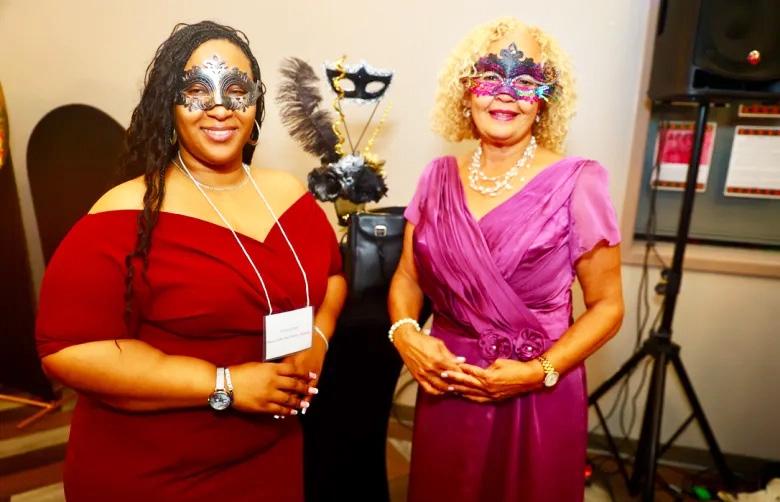


erally life-saving investments that allow us to care for our most vulnerable.”
State Sen. Derek Slap, D-West Hartford, said federal cuts to food and energy assistance programs means the legislature and governor will have to “step up” in the upcoming special session to help address basic human needs.
“The cold weather is coming and we know that for many folks, that’s going to mean life and death decisions,” he said. “I think many people think homelessness is something that happens to somebody else and it doesn’t affect them. But in reality, so many of our constituents are one paycheck away, one healthcare calamity away from finding themselves without a home or without heat.”
Lamont said the state had made improvements in increasing the housing supply, but that more work needs to be done. He expressed support for legislation that would cap the amount out-ofstate corporate rental purchasers can raise rents, and for continuing negotiations on a comprehensive housing bill and permanent cold weather funding for shelters.
“This is a down payment on what we’ve got to do to make sure in this cold weather, we can provide a little bit of extra support,” he said.
Con’t from page 10
the back room, the board room, the ballroom, and anyone’s living room.
Clark was just getting started in civic life: After handing control over a transformed arts council, she served eight years as a downtown alder, returning to her first love of politics. As in the arts job, she was the underestimated grown-up in the room. She never took people’s histrionics personally. And she could be blunt: When one constituent complained about noisy early-morning trucks, she responded: “You live in a city!”
Babz Rawls-Ivy, who served with Clark on the Board of Alders and later as arts council chair encountered her often in cultural circles, remembered her as a “remarkable woman way ahead of her time. She was talking about equity and inclusion 25-plus years before it became a growing ground breaking policy shift.” Rawls-Ivy recalled a community issues-oriented meeting attended mostly by white people. “If you look around the tables you sit at and you don’t see diversity,” she recalled Clark saying, “then you better get to the business of changing who’s at the table making decisions about communities you serve and have your table look like that!”
Clark followed that stint at 79 years old with a six-year run building the Home Haven nonprofit into a network of 250 seniors able to stay in their homes while connected to needed help and social activity. She also continued to help artists pursue their dreams, linking, say, an emerging playwright like Steve Driffin with people who could help him stage his

Abiba Biao
To the gentle strum of a guitar, Jacqueline Buster eased into James Taylor’s 1971 “You Can Close Your Eyes,” letting herself feel the lyrics. Moments before, she had looked out into the audience, and asked who among them had lost a loved one. Hundreds of hands went up.
No one would have guessed that she hadn’t performed in 40 years; the sweetness of the melody wrapped the room in its sound. As she finished, she assured the audience that it was safe to rest, mourn those who have passed, and cherish the future memories with family and loved ones.
Joyful, mellow, and sometimes fiery sound filled Toad’s Place on a recent Sunday night, as musi-cians paid tribute to the late guitarist Rohn Lawrence, a pillar of New Haven jazz, R&B, and pop who also traveled the world with his craft. Three years after Lawrence was sent off in song from the Toad’s Place stage, artists returned to remember their friend and colleague, raising funds for the neighborhood hub The Shack in the process.
Located on 333 Valley St. in New Haven’s West Hills neighborhoods, The Shack is a community center that Ward 30 Alder Honda Smith founded in 2021. The space serves teenagers to elders and offers urban farming, music production and composition, media arts classes in journalism and me-dia production, among other activities.
It is also in the process of building out a space for music production in West Hills, an initiative that Smith estimates will cost $200,000. In addition to ticket sales, the concert offered raffle tickets and custom t-shirts and sweatshirts from the New Haven-based brand Deadby5am, the brainchild of creator Brenton Shumaker. Shumaker, who began to sew as a kid, is currently based out of a space at NXTHVN.
“There's no better organization that I

can think of that meshes so well with, you know, who we are,” Buster said of the Shack’s partnership with her organization, Still in the Ville. Around her, the performance featured artists such as Jay Rowe, saxophonist Marion Meadows, and vocalist Porter Carroll, Jr. among others. All of them played with Lawrence; some, like Buster, remained extremely close with him until his death. Throughout the night, both performers and attendees fêted Lawrence, noting how much he would have loved the work that The Shack is doing for young people. During his life, the guitarist was a mentor to dozens, if not hundreds, of up-andcoming New Haven musicians, who have
since gone on to forge artistic and educational careers of their own.
Community booster Veronica Douglas-Givan, who emceed the event, said she could envision Lawrence smiling down on the audience, “saying, ‘Well done. Well done you crazy people!’” For years now, she’s been working to spread the word about The Shack across and beyond New Ha-ven, because she’s so excited about the mission.
It’s about “not just existing in New Haven, but really living in New Haven and putting your dollars in New Haven to let them understand that we care about our young people,” she said.
She explained that her own story fuels
her dedication to the city’s youth. Growing up in Newhall-ville, Douglas-Givan had dreams of becoming a rapper. Then in high school—she attended the now-shuttered Richard C. Lee High—a guidance counselor and journalism teacher pulled her aside and suggested that her gift for writing could take her beyond poetry. She took their advice, pursuing undergraduate and then graduate work at Northeastern University and Quinnipiac University respectively. Now, she’s an Emmy award winner, teaches in the Com-munication, Film and Media Studies Department at the University of New Haven, and is the CEO of her own media company, the Veronica Douglas Media
Agency. It is exactly those same skills she seeks to pass onto the next generation.
“Keep a word in your head, positive words, and a song in your heart and that will get you through a lot of different things,” she said. “Because it was that music, that storytelling that got me through.”
On stage, music bloomed into an homage that was mellifluous and varied enough to reach the heavens. The bongos, cymbals and drums built the foundation before the piano keys sauntered in. It was pa peppy, grooving tune that got people bopping their heads.
As she listened, Buster noted that “there's something different about this year.”
“It's special. There's something different about the energy among the musicians … It's just a differ-ent kind of experience,” she said.
She said that the venue, where Lawrence played a Monday night jazz jam upstairs at Lilly’s Pad for over a decade, embodied the late musician’s carefree, easygoing energy. Her own performance was meant to tap into that spirit, as a warm nod to both Lawrence and to her mother, Jeannette A. Thomas, who passed away last year.
As Taylor’s lyrics filled the space —I don't know no love songs/And I can't sing the blues any-more/But I can sing this song/And you can sing this song when I'm gone—some attendees closed their eyes; others moved to the music.
“I heard this song a few weeks ago. It was in my spirit to do it, for him and for my mom because it just kind of gives you the permission to pass and that it’s going to be ok,” she said. “In Rohn’s case, it’s about carrying on the legacy and knowing that wherever he is it’s going to be ok.”
Bridgeport, CT – October 3, 2025 — Bridgeport Public Schools have worked to find a solution to ensure students and staff have the support and resources they need in the classroom. At the Board of Education meeting on Thursday, October 2, 2025, the Board approved the restoration of kindergarten paraprofessionals across the district. Last spring, the district faced historic budget challenges that forced the elimination of kindergarten paraprofessionals. While this decision was necessary at the time to close a significant funding gap, it was never considered ideal. Since that day, the district has actively explored multiple ways to restore these vital positions. By implementing a plan to reduce the estimated cost of substitute teachers, Bridgeport Public Schools identified a creative solution that makes it possible to return paraprofessionals to kindergarten classrooms.
“Restoring kindergarten paraprofessionals is about doing what is right for our stu-
dents,” said Interim Superintendent Dr. Royce Avery. “We understood the impact of these positions being cut, and we worked to find a solution that would bring them back as quickly as possible. This decision ensures that our youngest learners and their teachers have the support they need in the classroom.”
The restoration of paraprofessionals has been welcomed by educators and leaders across the district.
Jeff Morrissey, President of the Bridgeport Education Association/Teachers Union (BEA), stated:
“The BEA is extremely pleased that the kindergarten paraprofessionals will be return-ing to the classroom. We would like to applaud the efforts of all who have advocated for their return. Our kindergarten teachers have done a phenomenal job in continuing to tirelessly educate their students during this difficult time and should be commended for doing so. This clearly

shows what can be accomplished when we come together.”
Steven Douglas, President of the Bridgeport Council of Administrators and Supervi-sors (BCAS), added:
“As the BCAS president, I am very pleased with the reinstatement of kindergarten paraprofessionals. This decision will provide essential support in our kindergarten classrooms and strengthen opportunities for our youngest learners to be actively en-gaged in the learning process.”
Kindergarten paraprofessionals assist with classroom management and create safe and engaging learning environments. Their restoration reflects the district’s commit-ment to listening to the needs of schools and the community while taking action to strengthen student learning.
Bridgeport Public Schools will begin the rehiring process immediately, with paraprofessionals expected to return to classrooms this school year.







By Stacy M. Brown Black Press USA Correspondent
In the first months of 2025, America’s safety net began to fray. From food banks to community health programs, thousands of nonprofits found their government funding delayed, frozen, or stripped away.
The Urban Institute’s October 2025 report, How Government Funding Disruptions Affected Nonprofits in Early 2025, captures what those on the ground already knew. The country’s moral infrastructure is buckling under the weight of political choices and bureaucratic neglect.
The report found that one in three nonprofits experienced some form of government funding disruption between January and June. Twenty-one percent lost at least some government funding. Twenty-seven percent saw funds delayed or frozen. Six percent received stop-work orders that halted programs entirely. These numbers, the research-ers wrote, reveal a “cascading effect” across the nation’s nonprofit landscape. Federal agencies began canceling grants and pulling back committed funds at the start of the year. “Organizations delivering job training, mental health services, independent living assistance, disaster relief, and emergency shelter, among other services, were forced to suspend programs and lay off staff,” the report stated.
The pain stretched far beyond Washington’s directives. One nonprofit leader explained that “state and local government have stopped providing multiyear contracts as they assess what changes at the federal level will take place. This impacts our ability to fore-cast and plan budgets.” Another said, “There is concern that re-

maining federal grant funds will not be honored, even though we are in contract to provide the services. Also, if federal funding our state agency receives is cut, we will no longer receive operating support.” The data show how deep the shock runs. Large organizations with annual ex-penses above $10 million were the most affected, with 56 percent reporting at least one disruption. For smaller nonprofits operating on less than $100,000, 18 percent report-ed funding loss or delay. Across the sector, disrupted nonprofits relied on government sources for 42 percent of their total revenue, compared with 28
percent among all non-profits. For those hit hardest—groups experiencing three types of disruptions, govern-ment dollars made up 57 percent of their budgets. Even those not directly funded by government contracts felt the blow. “The broader pullback in federal funding is having a significant indirect effect,” one small nonprofit said. “As federal dollars diminish, both foundations and individual donors are shifting more of their resources to larger organizations… This dynamic is creating a growing level of financial uncertainty for small nonprofits more broadly.” Another added, “It’s not just govern-
ment funding that’s been impacted, it’s the broader environment this administration has created for organizations serving communities it deems inappro-priate or controversial.” The effects reached deep into communities. Fifteen percent of all nonprofits reduced their staff in the first four to six months of the year, nearly dou-ble the number from 2024. Among those affected by government funding disruptions, 29 percent reported staff reductions. For organizations facing three levels of disrup-tion, that figure climbed to 51 percent. Hiring plans also collapsed, falling from 52 per-cent at the end of
2024 to just 38 percent by mid-2025. One organization wrote, “Cash flow a serious issue due to funding delays. Have had hiring freeze in place most of FY 2025 Qtr 2.” Another said, “Funding uncertainties make it extremely difficult to plan short-term and certainly for the long term. We are trying to hold off on laying off or cutting hours, but not sure how much longer we can wait without some certainty going forward.” The loss of funding also meant fewer pro-grams and fewer people served. Twenty-three percent of disrupted nonprofits reduced their programs compared with 12 percent of all nonprofits. Twenty-one percent cut back on the number of people served. Nearly half—48 percent—of those who suffered three types of disruptions reduced their programs, while 38 percent reduced the num-ber of individuals reached.
As one nonprofit explained, “We are preparing to decrease our spending on food items to prevent us from having to make cuts in staffing. We are almost at our maximum number of meal recipients and have a capped number at 75 with our one cook.” Anoth-er warned, “Expect major impacts on the state budget from federal cuts, which will di-rectly affect state-funded programs we provide. We cannot make up for projected changes with fundraising.” Two-thirds of nonprofit leaders said they expect demand for their services to increase in the next 12 months. They foresee a storm of need they cannot meet. “Every action the government takes has a direct impact in the communi-ty,” one leader said. “With all the funding cuts, how can we help families to cover their basic needs?”
Written By Lexx Thornton, hbcunews.com
A recent report reveals a major shift in post-high school planning: a growing majority of American parents are actively supporting their teenagers in exploring options beyond the traditional fouryear college track.
According to a study released by the American Student Assistance (ASA), which surveyed over 3,000 middle and high school students, 70% of teens report that their parents are now more supportive of alternatives, including trade school, apprenticeships, and other career training programs.
This change in parental attitude is a direct response to two critical economic factors: the escalating cost of higher education and the increasingly uncertain job market for college graduates.
1. The average annual cost of college now exceeds $38,000, having more than doubled since the beginning of the century.
2. This expense has led to record levels

of student debt, but it often fails to guarantee employment.
“Parents are waking up. College doesn’t carry the same [return on investment] it once did because the cost is outrageous,
and the outcome is uncertain,” noted career strategist Trevor Houston of ClearPath Wealth Strategies. He added that students today face unprecedented debt, while job security after graduation is not
guaranteed. The study found that over 4 million Gen Zers are currently jobless, with some actively avoiding degrees they consider “worthless.”
As the traditional “college-to-career”
pipeline loses its appeal, families are recognizing the viability of vocational and skills-based pathways for achieving entry-level career success. Alternatives like skilled trades, boot camps, industry certifications, and occupational licenses offer faster and more affordable routes to the workforce.
“Many students today are looking for faster, more affordable routes to the workforce,” said Julie Lammers, executive vice president at ASA. “We need to do more to better support and validate those goals.”
Lammers emphasized that the current demand for skilled labor creates a significant opportunity. An aging workforce and a surge in demand for infrastructure, real estate, and energy production projects mean there are “considerably more job openings than skilled workers to fill the need.” This high demand is making hands-on training and trade careers increasingly attractive and profitable for students who choose to skip the fouryear degree.


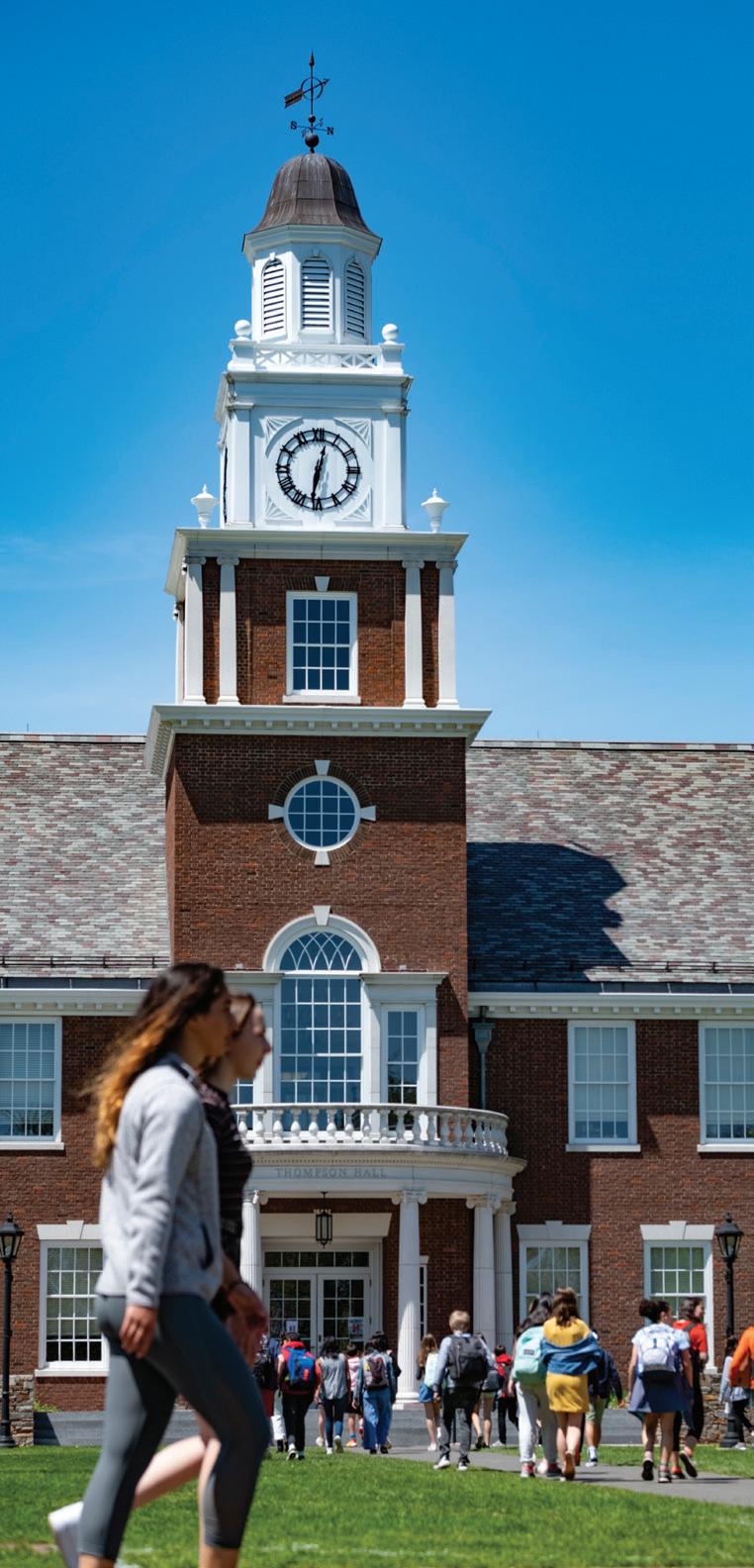

• Cremation (Choose to be cremated at Evergreen.)
• Columbarium in the Most Beautiful Cremation Garden
• Reserve your Niche in a secure location pre-need.

• Reserve a Niche for family and friends or purchase at-need to safely place your Loved One in the Columbarium.
• Burial Lots (infant, single, two-grave, or four-grave)
• Monuments & Markers (black, gray, or pink granite)
• Flower placement (single or multiple placement)
• All orders can be placed at the Evergreen office or the website.

by Barry Anderson, BlackDoctor.org
D’Angelo, the smooth, soul-sinning, super-talented, Grammy-winning R&B icon who helped launch the neo soul era in the ’90s, has passed away Tuesday after a battle with cancer, the singer’s family announced. He was 51.
“The shining star of our family has dimmed his light for us in this life,” they said. “After a prolonged and courageous battle with cancer, we are heartbroken to announce that Michael D’Angelo Archer, known to his fans around the world as D’Angelo, has been called home, departing this life today, Oct. 14, 2025.”
On Tuesday, Oct. 14, TMZ also reported that D’Angelo (born Michael Eu-gene Archer) “was in hospice for two weeks but had been in the hospital for months for pancreatic cancer” the source tells PEOPLE.com.
It was just in May of 2025, that the iconic R&B artist announced through social media that he had to cancel his headlining appearance at the Roots Picnic, scheduled for May 31 and June 1 at Philly’s The Mann in Fairmount Park. The decision was made following medical advice related to an “un-foreseen” delay in his surgical recovery.
“It is with the deepest of regrets that [I] must cancel my performance at the Roots Picnic in Philadelphia next weekend,” D’Angelo wrote in a statement shared through the Roots Picnic’s Instagram page. “But, due to an unforeseen medical delay regarding surgery I had earlier this year, [I’ve] been advised by my team of specialists that the performance this weekend could further complicate matters.”
While we don’t know what that specific surgery was, more reports are coming out about it, surrounding his pancreas and surrounding organs.
Black men have the highest age-adjusted incidence rate of pancreatic cancer among all racial groups in the United States, often being diagnosed at later

stages with fewer treatment options. This disparity is linked to a combination of risk factors, including environmental and socioeconomic factors like a higher prevalence of smoking and conditions such as diabe-tes and obesity, which disproportionately affect Black Americans. Access to care, participation in clinical trials, and consideration of surgery are key areas for intervention.
Environmental and socioeconomic factors: These are significant contribu-tors to the higher incidence in African Americans.
Lifestyle behaviors: Higher rates of cigarette smoking among African Americans contribute to pancreatic cancer risk.
Health conditions: Obesity and diabetes are more common in Black Amer-icans and are associated with an increased risk of pancreatic cancer.
Pancreatic cancer symptoms in men can vary and may include:


Common Symptoms:
• Abdominal pain: Often dull, persistent, and located in the upper ab-domen or back.
• Jaundice: Yellowing of the skin, eyes, and urine due to bile blockage.
• Weight loss: Unexplained and significant weight loss.
• Nausea and vomiting: Persistent nausea and vomiting, sometimes with abdominal bloating.
• Fatigue: Extreme tiredness and weakness.
Less Common Symptoms:
• Blood clots: Deep vein thrombosis (DVT) or pulmonary embolism.
• Diabetes: Sudden onset or worsening of diabetes.
• Constipation or diarrhea: Changes in bowel habits.
• Back pain: Pain that radiates to the back.
• Dark urine: Urine may appear darker than usual.
• Light-colored stools: Stools may appear lighter than usual. What can be done to Protect Our Black



Men
• Consult a doctor: If you are a Black man, be aware of the symptoms and discuss any concerns openly with a healthcare provider.
• Explore all treatment options: Seriously consider
• surgery if it is offered, as it is one of the only potential ways to cure the cancer.
• Consider clinical trials: Participation in clinical trials is associated with better outcomes. Despite the high need, Black Americans are significantly underrepresented in clinical trials.
• Advocate for palliative care: Ask your healthcare team about pallia-tive (supportive) care options to help manage symptoms and im-prove quality of life.
How D’Angelo Got His Start
The Richmond-born son of a Pentecostal minister began playing the piano at the age of 3, and by 5 years old D’Angelo was playing the instrument with his father at church. A few years later, he began playing the piano at his grandfather’s Pentecostal church.
Growing up, he and his two cousins



formed the group Three of a Kind and began performing at local talent shows. By 16, he formed another band called Michael Archer and Precise with his brother, Luther.
D’Angelo first broke through with the release of his debut album Brown Sugar in 1995. That album launched his first Top 10 single, “Lady,” and Brown Sugar went platinum. D’Angelo followed that up with the classic Voodoo in 2000, which debuted at No. 1 on Billboard’s 200 albums chart and won best R&B album at the 2001 Grammy Awards. The album’s sin-gle “Untitled (How Does It Feel)” won for best R&B performance. With the money he got from doing Amateur Night at the famed Apollo Theater, he returned to Richmond, bought a fourtrack recorder and start-ed writing what would become one o the foundational albums that helped usher in the neo-soul movement, his 1995 debut album, Brown Sugar. Brown Sugar peaked at No. 4 on the U.S. Billboard Top R&B Albums chart went platinum within a year of its release. It also earned D’Angleo four Grammy Award nominations.
Led by the provocative, nearly nude video for “Untitled,” 2000’s Voodoo was a very different story. It evolved from more than three years’ worth of sessions, mainly at New York’s Electric Lady Studios, and featured an im-pressive roster of soul, funk, and jazz players such as Roots drummer Ahmir “Questlove” Thompson, who became D’Angelo’s musical copilot, keyboardist James Poyser, guitarist Charlie Hunter and trumpeter Roy Hargrove. The Outpour of Love Continues on Social Media
DJ Premier, who collaborated with D’Angelo on the 1998 track “Devil’s Pie,” shared a post via X on Oct. 14 lamenting the news.
“Such a sad loss to the passing of D’angelo. We have so many great times. Gonna miss you so much. Sleep Peacefully D’ Love You KING,” DJ Premier wrote.
D’Angelo leaves behind a son born in 1998 from his relationship with singer Angie Stone (who herself died last year), and two other children, a son and daughter.
Rest well, my brother. You are missed.
By National Head Start Association
October is Head Start Awareness Month. There is no singular look to Head Start — its federal-to-local structure has served communities and families well over the past six decades, benefiting from the ability to adapt and connect to the unique priorities of in-dividual communities. National standards ensure a baseline of quality. In addition, Head Start programs demonstrate a rich breadth and depth of services across locations — reflecting the spirit, priorities, and cultures of local communities and the parents who help lead each program. The following examples, a small selection from a broader na-tional compendium, illustrate some of the myriad ways that Head Start is adaptable, flexible, and provides communities with the ability to best meet the needs and prefer-ences of local families and children.
Head Start programs create engaging environments to encourage children’s natural curiosity and exploration and foster a love of learning.
Through quality teacher-child interactions, strong developmental standards, and locally chosen curricula, Head Start ensures all children are ready for kindergarten. Since its inception in 2012, the highly popular Mandarin program at Albina Head Start in Ore-gon has expanded from three classrooms to 17. Daily Mandarin instruction incorporates methods like singing, dancing, movement, art activities, and games. This approach al-lows children to learn another language while having fun. In Ohio, the Aullwood Audu-bon Center and Farm partners with the Miami Valley Child Development Centers to op-erate a Head Start classroom on a working farm. The program meets all Head Start standards and follows the High Scope curriculum. The children also spend extensive time outdoors on the farm every day, even doing farm chores.
Head Start ensures that geography or unique circumstances are not obstacles to getting a strong start in life. Whether located at the bottom of the Grand Canyon

for remote families or on military installations for active service families, Head Start is there. The Rural Alaska Community Action Program provides homebased Early Head Start ser-vices to meet the needs of eight remote Alaska Native communities that engage in sub-sistence activities, including moving to itinerant fish camps during the summer months.
The Fort Carson Head Start Center, located on the Fort Carson (Colorado) army base, serves more than 100 children, more than 80% of whom have a parent serving in the military. The program is especially equipped to address separation issues that come with parental deployment.
Head Start addresses critical health and nutrition needs so that children are fully
ready to learn and grow.
It ensures children who otherwise may be experiencing food insecurity are provided with nutritious meals and snacks, often including months when the program is closed. And Head Start brings health services where they are needed most, directly to children while at school or to them and their families through mobile
health units and local community health and dental clinics. Through on-site food pantries with local fresh veg-etables and dairy, gardens in the outdoor space, hydroponic plant towers, and a from-scratch kitchen, Colorado’s Clayton Early Learning provides children and parents with nutritious food options for their families.
The Anoka/Washington County Head Start in Minnesota partners with two local dental clinics to provide on-site dental services for their children and families. This has made it possible to avoid long waiting lists and get necessary dental care much sooner than would be the case in the community at large.
Head Start meets children’s early intervention needs more readily than most other community options.
Recognizing the gap in services for children with low vision and blindness, the Los Ange-les Office of Education and the Blind Children's Center created Early Head Start main-stream classrooms that specialize in supporting children with visual impairments. They also help parents and caregivers learn the specialized skills needed to support their vi-sion-impaired child’s growth. In 2020, Indiana’s Community Schools Head Start took a creative approach to addressing their children’s anxiety and mental health challenges caused by the pandemic: a therapy dog. Westin, the therapy dog, helps children regulate their emotions, cope with separation anxiety from their parents, practice patience, and much more.
Head Start provides a two-generation approach to lift families out of pov-erty, recognizing that empowering parents helps strengthen families. Through Head Start, parents and caregivers are supported in their efforts to enroll in work and adult education programs, connect to community resources, and engage in parenting activities that emphasize their role as their children’s first teacher. At the Genesis Center in Rhode Island, parents and children learn together. Through the Chil-dren’s Friend Early
By Lauren Burke
Carolyn Jean Cheeks Kilpatrick, an assertive advocate for Detroit and Black owned busi-nesses, died on October 7 in Atlanta. She was 80. The former Congressman first won election to the U.S. Congress in 1996 and served until 2011 after losing a primary elec-tion in 2010 to former Congressman Hansen Clarke. Kilpatrick was elected Chair of the Congressional Black Caucus in 2006 and served as Chair from 2007-2009. Kilpatrick was an outspoken and assertive member of the CBC. She fought for an increase in the federal minimum wage and was an energetic advocate for Black owned businesses. She also pushed for millions in needed funding to Haiti and sub-Saharan African nations. Kilpatrick founded the Sojourner Truth Legacy Project at the Congressional Black Caucus Foun-

dation. Perhaps most notably, the former Con-gresswoman served on the powerful House Appropriations Committee.
According to a family statement, “Con-
gresswoman Kilpatrick secured a seat on the powerful Appropria-tions Committee where, among others, she empowered the people of the State of Michi-gan with over $1.5 billion in projects ranging from the revitalization of Detroit’s Water-front, rehabilitation of the Detroit Medical Center, light rail, and Michigan’s universi-ties. Congresswoman Kilpatrick also brought attention and secured millions in funding for many sub-Saharan African nations. In the history of Michigan, no other Member of Congress secured as much direct or indirect funding for the state. None.”
Kilpatrick was a former public-school teacher for a decade and began her political career as a mentee of former Detroit Mayor Coleman Young. She served for 18 years in the Michigan House of Representatives and was the first Black woman in history to serve on the Michigan House’s powerful Appropriations
Committee. “Congresswoman Carolyn Cheeks Kilpatrick’s legacy encompasses her decades-long advocacy for her Detroit con-stituents as a teacher and member of Congress. As the second Black woman from Michi-gan to ever serve in the U.S. House, Congresswoman Kilpatrick played a vital role in se-curing federal funds to help the state of Michigan and its residents.
In 2008, when the Joint Center launched the Commission to Engage African Americans on Climate Change, Congresswoman Kilpatrick was among a small group of representatives who recognized the importance of this group and offered her support. A few years later, she worked more closely with our organization as a member of the Joint Center’s Board of Governors. Her commitment to addressing the evolving needs of Black Americans, through climate justice, economic empowerment, and community development, reflect-ed
her deep understanding of the issues that matter most. Our thoughts and prayers go out to her family during this difficult time,” wrote Dedrick Asante-Muhammad on Con-gresswoman Kilpatrick in a statement on October 8.
The well-known former Congresswoman was born Carolyn Jean Cheeks on June 25, 1945. She was raised in the African Methodist Episcopal Church and was connected to public service at an early age. She was a graduate of Detroit’s High School of Commerce, where she served as class president. Kilpatrick earned an associate's degree from Ferris State University and a bachelor’s degree from Western Michigan University. She then earned a graduate degree from the University of Michigan. The Congresswoman is sur-vived by her daughter, Ayanna Kilpatrick, and her son, Kwame Kilpatrick. Funeral ar-rangements will soon be announced.
FOR THE ELM CITYCOMMUNITIES, HOUSING AUTHORITY OF NEWHAVEN (ECC/HANH)
PROPOSED AMENDMENT TO THE LIPH ADMISSION AND COMTINUED OCCUPANCY PLAN (ACOP) AND HCV ADMINISTRATIVE PLAN (ADMIN PLAN)
Elm City Communities, the Housing Authority of the City of New Haven (ECC/HANH) is propos-ing to amend sections of its Low-Income Public Housing Admissions and Continued Occupancy Policy (ACOP) and the Housing Choice Voucher (HCV) Administrative Plan (Admin Plan).
The thirty (30) days comment period begins on Monday, September 29, 2025, and ends on Tuesday, October 28, 2025. Copies of the amendment to the ACOP and the Administrative Plan will be available on the agency website www.elmcitycommunities.org or via Facebook, www.facebook.com/ElmCityCommunities and Instagram, elmcitycommunities_hanh.
You are invited to provide written comments addressed to: ECC/HANH, ACOP & Admin Plan Revisions; Attn: Evelise Ribeiro, 360 Orange Street, New Haven, CT 06511 or via email to: eribei-ro@elmcitycommunities.org.
A public hearing where public comments will be accepted and recorded is scheduled for Mon-day, October 27, 2025,3:00pm, via TEAMS.
ID: 298 581 151 620 1 Passcode: WP7wr6tg Dial in by phone
+1 872-240-4494,747680648# United States, Chicago Find a local number Phone conference ID: 747 680 648#
Any individual requiring a Reasonable Accommodation to participate in the hearing may call the Reasonable Accommodation Manager (203) 498-8800, ext. 1507 or at the TDD Number (203) 497-8434.
ELM CITYCOMMUNITIES, AUTORIDAD DE VIVIENDA DE NEW HAVEN (ECC / HANH) PROPUESTA DE EN-MIENDA AL PLAN DE ADMISIÓN Y OCUPACIÓN COMTINUADA (ACOP) DE LA LIPH Y AL PLAN ADMINISTRATIVO DE AVC (PLAN ADMIN)
Elm City Communities, la Autoridad de Vivienda de la Ciudad de New Haven (ECC / HANH) está proponiendo revisar secciones de su Política de Admisiones de Vivienda Pública de Bajos Ingresos y Ocupación Continuada (ACOP) y el Plan Administrativo de Vales de Elección de Vivienda (HCV) (Admin. Plan).
El período de treinta (30) días para presentar comentarios comienza el lunes 29 de septiembre de 2025 y fi-naliza el martes 28 de octubre de 2025. Copias de la enmienda al ACOP y al Plan Administrativo estarán dis-ponibles en el sitio web de la agencia, www.elmcitycommunities.org, o a través de Facebook, www.facebook.com/ElmCityCommunities e Instagram, elmcitycommunities_hanh.
Le invitamos a enviar sus comentarios por escrito a: ECC/HANH, ACOP y Revisiones del Plan Administrativo;
Atención: Evelise Ribeiro, 360 Orange Street, New Haven, CT 06511, o por correo electrónico a: eribei-ro@elmcitycommunities.org.
Se ha programado una audiencia pública para el lunes 27 de octubre de 2025 a las 15:00 h, a través de TEAMS, donde se aceptarán y grabarán los comentarios del público.
ID: 298 581 151 620 1 Contraseña: WP7wr6tg Llamar por teléfono +1 872-240-4494,747680648# Estados Unidos, Chicago Buscar un número local ID de conferencia telefónica: 747 680 648#
Cualquier persona que requiera una adaptación razonable para participar en la audiencia puede llamar al Gerente de Adaptaciones Razonables al (203) 498-8800, ext. 1507 o al número TDD (203) 497-8434. Cualquier persona que requiera una adaptación razonable para participar en la audiencia puede llamar al Gerente de Adaptaciones Razonables al (203) 498-8800, ext. 1507 o al número TDD (203) 497-8434.

The Housing Authority City of Bristol (BHA) is seeking proposals from qualified firms for ongoing Information Technology (IT) and Computer Support Services through help desk support as well as onsite support. Proposals are due on or before November 6, 2025, at 3:00 PM.
The complete RFP documents can be obtained at www.bristolhousing.org or by contacting Luis Velazquez, Director of Capital Funds, at lvelazquez@bristolhousing.org or phone 860-585-2028. Interested parties are invited to a pre-bid conference held on October 23, 2025, at 11:00 AM at 164 Jerome Ave., Bristol, CT.
The Housing Authority of the City of Bristol is an Equal Opportunity/Affirmative Action Employer. SBE, MBE, W/DBE, and Section 3 businesses are encouraged to respond.

Sound Communities, Inc., the development arm of the Norwalk Housing Authority, is seeking qualifications from experienced and capable development firms to serve as Co Developer for the planned SoNo Train Station Project. The selected firm will partner with Sound Communities, Inc., in all phases of project activities including but not limited to predevelopment, financing, construction, and lease-up operations. Interested parties must demonstrate proven experience in housing development, developing 9% LIHTC projects , and management of multi phase projects, as well as familiarity with applicable local, state, and federal regulations. RFQ documents are available at www. norwalkha.org under Doing Business handle. Submissions must be received no later than November 7th, 2025, at 5:00 PM EST. to sstewart@soundcommunities.ct.org, or for more information, contact Sophia Stewart, Project Coordinator, sstewart@soundcommunitiesct.org. Norwalk Housing Authority is an Equal Opportunity Employer.
Submission due date: November 7th , 2025, at 5pm Send proposals to: sstewart@soundcommunitiesct.org
Request for Information must be submitted by: October 24th , 2025 Send Request for Information to: sstewart@soundcommunitiesct.org
241 Quinnipiac Avenue, New Haven which are two bedrooms and rent from $1,950-$2,000 and include heat, hot water and cooking gas, private entrance, off street parking and onsite laundry. I have a couple with washer/dryer which are $2,000. Please bill 241 Quinnipiac Avenue, LLC, 111 Roberts Street, Suite G1, East Hartford, CT 06108.
Also, I have a 3 bedroom unit at 254 Fairmont Avenue, New Haven. They rent for $2,050 and the tenant pays all the utilities. Off street parking and private entrance. Section 8 welcomed.
Also, I have a 2 bedroom at 248 Fairmont Avenue, New Haven. They rent for $1,950.00 and the tenant pays all the utilities. Off street parking and private entrance. Section 8 welcomed.
Please bill the Fairmont Avenue to 258 Fairmont Avenue, LLC at the same billing address as 241 Quinnipiac Avenue. I will be the contact person for them to call at 860-231-8080, ext. 161.
The Town of Wallingford, CT is accepting applications for Metering Supervisor. Wages: $115,203 to $144,003 annually. For additional information and to apply online be the November 4, 2025 closing date, please visit: www.wallingfordct.gov/government/departments/human-resources/. Applications are also available at the Department of Human Resources located in Room #301 of the Town Hall, 45 South Main Street, Wallingford, CT 06492. Phone: (203) 294-2080; Fax: (203) 294-2084. EOE
The Town of Wallingford Department of Public Works has openings for Maintainer II. Applicants should possess 2 years’ experience as a laborer in construction work involving the operation and care of trucks and other mechanical equipment, or 2 years training in one of the skilled trades and 1 year of experience in construction operations, or an equivalent combination of experience and training. A valid (CDL) Class B or higher is required. $24.87 - $29.16 hourly plus retirement plan, paid sick and vacation time, life insurance, 13 paid holidays, family medical & dental insurance, and promotional opportunities. To apply online by the closing date of September 12, 2025, please visit: www.wallingfordct.gov/government/de partments/human-resources/. Applications are also available at the Department of Human Resources located in Room #301 of the Town Hall, 45 South Main Street, Wallingford, CT 06492. Phone: (203) 294-2080; Fax: (203) 294-2084. EOE
Request for Proposals
Workers Compensation Insurance Program
360 Management Group, Co. is currently seeking proposals from a firm for workers’ compensation services to ensure compliance with Connecticut Workers’ Compensation laws, OSHA standards, and applicable HUD requirements. A complete copy of the requirement may be obtained from 360 Management Group’s Vendor Collaboration Portal https://newhavenhousing.cobblestonesystems.com/gateway beginning on
Monday, October 20, 2025 at 3:00PM.
Project Manager Consulting Services - 64-66 Wasson Avenue, Lackawanna, New York. (Section 141,43, Block 2, Lot 20,21,22,23,24,25,40,41,42,43,44,45,46,47,1)
The Glendower Group is seeking proposals from firms for project management services for a Project located at 64-66 Wasson Avenue. New York. A complete copy of the requirement may be obtained from Elm City’s Vendor Collaboration Portal https://newhavenhousing.cobblestonesystems.com/gateway beginning on
Wednesday, October 8, 2025, at 3:00PM.
Opening for a full time HVAC/Oil/Heating Technician Apprentice. Candidate must possess a technical school certificate in heating, ventilation, air conditioning, oil, propane and natural gas. Send resume to: HR Manager, P. O. Box 388, Guilford, CT 06437 or email HRDept@eastriverenergy.com
**An Affirmative Action/Equal Opportunity Employer including Disabled and Veterans**

The State of Connecticut, Office of Policy and Management is recruiting for a Criminal Justice Policy Assistant Division Director (Office of Policy
Maintenance workers needed for the Wallingford Public Schools to work the 2:00 P.M. to 10:00 P.M. shift. Hourly rate: $20.27 to $26.41. Requires some experience in building maintenance work. The closing date will be October 20, 2025. To apply online, please visit: www.wallingfordct.gov/government/departments/human-resources/. Applications are also available at the Department of Human Resources located in Room #301 of the Town Hall, 45 South Main Street, Wallingford, CT 06492. Phone: (203) 294-2080; Fax: (203) 294-2084. EOE

The Town of Wallingford, CT is accepting applications for Metering Supervisor. Wages: $115,203 to $144,003 annually. For additional information and to apply online be the November 4, 2025 closing date, please visit: www.wallingfordct.gov/government/departments/human-resources/. Applications are also available at the Department of Human Resources located in Room #301 of the Town Hall, 45 South Main Street, Wallingford, CT 06492. Phone: (203) 294-2080; Fax: (203) 294-2084. EOE

THE HOUSING AUTHORITY OF THE CITY OF NORWALK, CT IS REQUESTING PROPOSALS FROM QUALIFIED INDEPENDENT PUBLIC ACCOUNTING (IPA) FIRMS OR INDIVIDUALS TO PROVIDE AUDIT SERVICES FOR ITS PORFOLIO OF ASSISTED HOUSING AND RELATED PROGRAMS. TO OBTAIN A COMPLETE COPY OF THE REQUEST FOR PROPOSAL DOCUMENTS,
CONTACT GUILLERMO BENDANA, PROCUREMENT SPECIALIST AT GBENDA@NORWALKHA.ORG PROPOSALS ARE
NORWALK HOUSING IS AN EQUAL OPPORTUNITY EMPLOYER. ADAM BOVILSKY, EXECUTIVE DIRECTOR.
The Glendower Group, Inc. is currently seeking bids for General Contractor for ST. Lukes Redevelopment. A complete copy of the requirement may be obtained from Glendower’s Vendor Collaboration Portal https://newhavenhousing.cobblestonesystems.com/gateway beginning on
Wednesday, September 24, 2025, at 3:00PM.
By April Ryan
The White House wants to invoke the Insurrection Act as the Trump administration continues to target Antifa, which they consider leftist terrorist cells. An Antifa designa-tion could also, in turn, render a classification as domestic terrorists. This Trump mes-sage was taken abroad last month. An American traveling with the White House press corps asked the British Prime Minister, Keir Starmer, if he would follow America’s lead and disavow Antifa.
Compounding the problem is the Insurrection Act, a federal law that gives the U.S. president the power to deploy the military or federalize National Guard troops within the country to suppress insurrections, rebellions, or other severe civil unrest. The worry is that President Trump is ready to make that declaration amid current tensions across the country. The fight against what MAGA considers Antifa is playing out in Portland, Oregon, and Chicago, Illinois. Where some residents call it a “war zone.” Trump's loyal-ist and White House senior policy advisor, Stephen Miller, questions why there is un-rest when a National Guard

cheering vector illustration
presence is evident in a city?
Trump officials allegedly sent the National Guard to protect Portland, Oregon's, offices and federal buildings. The mayor of Portland is a white Democrat,
Kieth Wilson, who leads the latest test case city that President Trump says is plagued with crime. Chicago is another “war zone” after President Trump sent the National Guard there recently. Pro-
tests have erupted due to the troop presence along with federal immigration offi-cials. The administration's targeting is not just for so-called crime-ridden cities. Organ-izations are also on the administra-
tion's radar.
Further south in the red state of Texas, it is launching investigations into what they call racial leftist organizations. The state attorney general is launching the probes. Also, pro-foundly, in recent weeks, in mid-September, one of the founders, who no longer works with Black Lives Matter Global Network Foundation, had her phone taken by federal agents. That phone confiscation was part of a house raid believed to be part of a much larger federal investigation by the FBI. Sources near the organization confirm the Network is a grant-making organization that has given 40 million dollars to Black-led, front-line, grassroots organizations and impacted families throughout the country and the world, including for people building three water wells in Ghana, Africa. Ironically, Charlie Kirk posted about the organization on his account the day he died. At this point, there is no correlation between the FBI probe and Kirk's social media posts. Civil rights organizations are actively concerned that any direct action, meaning protest for causes that advocate for Black or brown people, will be targeted by this ad-ministration to be deemed domestic terrorism.
By Stacy M. Brown Black Press USA Correspondent
The White House has continued to wage war against the American people — not through bombs or foreign troops, but through policies that strip workers of their dig-nity, their pay, and their hope. The cruelty is no accident. It is deliberate, orchestrated, and flaunted as a spectacle of power. America’s government has turned its might in-ward, and its victims are the citizens who once believed they were free.
A newly revealed memo from the Office of Management and Budget claims that federal workers forced into furlough during the ongoing shutdown may not receive back pay once the ordeal ends. In open defiance of the law, the administration argues that the 2019 Government Employee Fair Treatment Act does not automatically guarantee wag-es to workers sent home or ordered to labor without compensation. The government that once promised fairness has now declared that those who serve it may be discarded. This is not confusion. It is control.
Mark Paoletta, the administration’s top lawyer at the budget office, wrote that Congress must pass new legislation to authorize those pay-ments. His reasoning is what one former Republican official called “clearly against its intent.” In other words, the government rewrote the law to justify punishing the very people who keep it running.
President Trump offered no compassion, only contempt. “It depends on who we’re talking about,” he said when asked if fur-

loughed workers would receive back pay.
“There are some people that really don’t deserve to be taken care of, and we’ll take care of them in a different way.” Those words echo not from a leader, but from a ruler measuring human worth as though it were a currency. Across the country, millions now live the consequences of those words. Families of federal workers stare at empty refrig-erators – the most recent estimate revealed that more than 49,000 District residents, or 13 percent, are federally employed – and rent notices pile
up. CNN reported that many workers will receive smaller paychecks this week, the last they may see until the shutdown ends. What kind of democracy weaponizes hunger against its own citizens?
The administration’s defiance also contradicts its own Office of Personnel Manage-ment, which stated that “employees who were furloughed as a result of the lapse will receive retroactive pay for those furlough periods” once the shutdown ends. But this White House does not deal in law; it deals in loyalty.
It rewards obedience and punish-es dissent. It governs by threat and humiliation. Senator Patty Murray called the memo a “baseless attempt to try and scare and intimidate workers by an administration run by crooks and cowards.” Everett Kelley, president of the American Federation of Gov-ernment Employees, said the livelihoods of federal employees “are not bargaining chips in a political game.” But that is precisely what they have become — bargaining chips in a government of vengeance.
This administration treats suffering as performance art. It praises soldiers while starv-ing civilians. Trump told sailors at a naval ceremony not to worry about their paychecks, promising they would “get every last penny.” The message was unmistaka-ble: the military will be fed; the rest of you can starve. Federal employees, once seen as the backbone of public service, are now branded as enemies of the state. The same gov-ernment that sends the National Guard into American cities and deploys ICE agents to terrorize neighborhoods now tells its own workers they may never be paid. It is no longer governance; it is domination. The America that claimed to be the light of the free world now stands as a warning to it. Robert Shea, a former budget official, said the administration’s argument was “clearly against its intent,” but intent no longer matters when a nation loses its soul. This is the transformation from republic to regime — a process that does not happen with tanks in the street, but with memos like this one. Quiet signatures. Cold language. Lives de-stroyed by decree. This is how democracies die — not with the roar of invasion, but with the silence of compliance. Each paycheck withheld, each family broken, each law rewritten becomes another nail in the coffin of a nation that once called itself free. The war is not over there. It is here. It is the war of the state against its own people. A war fought with hunger, humiliation, and fear. A war that reveals what America has become — a country where cruelty is not the failure of policy, but the policy itself.
by LOIS ELFMAN
Enthralled with dance, a 14-year-old girl adopted a new first name, Dancette, and a lifetime love was cemented. In 2007, when Dancette Pratts’ longtime teacher and mentor, Bette White Fernandez (who passed away earlier this year), decided to retire after 54 years, she turned over her dance stu-dio to Pratts, who had begun teaching dance at the precocious age of eight.
It had always been a place where dancers of all ages came, and today, Inspirational Dance Studio in Maplewood, New Jersey, is a space where all are welcome to come, learn, and celebrate the art of movement while finding community. While diverse students were always welcome, under Pratts’ leadership the number of students of color grew exponentially, particularly as students started per-forming in local shows. A variety of dance styles are taught, from contemporary to ballet, jazz, tap, African, hip hop, Latin, and breakdancing.
“Teachers don’t listen to their kids

sometimes, but I listen to them and I hear their ideas,” said Pratts. “I’ve brought in a lot of the Afro beats, Latin — salsa, merengue, bachata — and made it more modernized and not so the old school
way. The girls feel welcome, they [are] at home and they feel heard. They feel they can still express their style of dance within the dance community and the structure we have as well.”
Dance competitions are very popular, and Inspirational Dance is on board. There is a team of 16 dancers who perform solos, duos, trios, and small and large groups, performing all different

styles. They have won many awards, including a prestigious competition at Disney. This past weekend, Inspirational Dance Company danced at MetLife Field for the New York Jets game against the Dallas Cowboys.
Pratts said at dance competitions, people wonder where these excellent dancers come from. “We’ll come in and they’re
like, ‘What are you going to do, hip hop?’” said Pratts. “Then we’re winning tap and contemporary and different styles of dance … The majority of those competitions are white, and we do bring the color in there and the originality of what’s really happening now.”
Pratts, who has danced professionally, and her staff see to it that the girls display meticulous tech-nique in competition. Some students have professional aspirations — including a few who act, sing, and dance — while others just want to express themselves. Some former students have gone into medical fields as nurses and physical therapists.
There are also adult classes in a variety of styles. While some grownups take dance quite seriously, others just enjoy the activity. Her goal is to keep everyone loving dance and to help the young dancers achieve their dreams.
“Keep growing these dancers and see them excel to the next level,” said Pratts. “What I love about Inspirational Dance Company is that I get to know them as not only my students and dancers, but I really get to know them as artists. Seeing them grow to whatever they want to do in their careers and paths, that’s my biggest thing.” For more info, visit inspirationaldance.com.
by LOIS ELFMAN
It has been an eventful few months for professional boxer Stacia “The Natural” Suttles. The Bronx native dominated her fights as part of Team Combat League (TCL), helping the New York City Attitude to the championship and being named Most Valuable Fighter of the 2025 TCL postsea-son.
“I had really good fights; I actually ended up having 15 consecutive wins, two knockouts within the season,” said Suttles. “The NYC Attitude made it into the playoffs by kind of the luck of the draw. … We were out of the playoffs and then the week before the playoffs started, we got a call that a team was eliminated for various reasons, so we were in the playoffs.
“First, we beat a team that beat us twice, then we beat the top team of the league, an undefeated team,” she added. “In the finals, we were fighting Philly, a team that we also lost to twice and we ended up beating them by one point in the finals. It was like a movie moment.”
Suttles hopes that the next scene in the movie involves signing with a promoter and starting to have regular professional fights. TCL has been a fantastic experience and the championship is sweet, but each fighter on the team only fights one round. Undefeated as a professional, 2–0 with one KO, she is eager to see herself

on traditional fight cards.
“A goal I had going into TCL was to gain exposure, show promoters who I am, what I’m about, show them my fighting style, and I was able to do that,” said Suttles, 31. “I’m hoping that it turns into a good contract with a big promotional company. That really is my goal.”
Until the ink is dry on a contract, Suttles, who currently lives and trains in Philadelphia, has con-tinued to run her business helping children and adults develop social and emotional skills through
boxing. She teaches in after-school programs, summer camps, and does private coaching. One day this summer, she attended a summer camp at the Haverford School for half the day and then went to a weigh-in for a TCL fight.
“I definitely recommend Team Combat League to amateur boxers coming into the pro ranks that want to get that experience,” said Suttles. “Now, I want to continue in the traditional avenue of pro-fessional fighting. … Hopefully, by the end of the year we’ll have something set.”
by Mildred Europa Taylor, Face2FaceAfrica.com
Ashley Allison, a Democratic political strategist and CNN commentator, said last week that she is acquiring The Root from G/O Media, a digital media holding company controlled by a private equity firm.
The Root, a digital platform for and about Black America, is return-ing to Black ownership thanks to Allison’s move. The former Obama White House official said she plans to invest in video con-tent, build new partnerships with experts, and create in-person ex-periences for readers, according to CNN.
“This isn’t about making more content but rather about making meaning of this moment,” Allison said, describing a period “when journalism is under attack and audiences are seeking independent sources for news.”
Allison founded her company, Watering Hole Media, last year, and The Root is its first acquisition. Terms of the deal are not yet known.
The Root was founded in early 2008 by Harvard University profes-sor Henry Louis Gates Jr. and then-chairman of The Washington Post Company Donald E. Graham.
In 2015, it was acquired by Univision,

a Spanish-language media company. It brought together a portfolio of online brands but later abandoned its plan and sold titles to Great Hill Partners, a private equity firm, in 2019, according to CNN.
G/O Media, which came to own The Root and other brands like The Onion and Kotaku, couldn’t grow as expected, and by last summer, The Root was the only brand
Gates has since commended Allison “for returning The Root to its roots.”
Allison, in a statement, said the website “has always been about preserving culture and creating clarity in a world full of distrac-tions. Owning the power to tell our own stories is a rich tradition The Root is committed to upholding.”
Besides founding Watering Hole Media, Allison helped start the Turner Colony Group and became its CEO. Turner Colony Group provides strategic advice, consulting, and leadership development and training services, usually centered on campaigns and companies.
Allison also served as the National Coalitions Director for the 2020 Biden-Harris presidential campaign. She further worked as the deputy director and senior policy advisor for the Obama White House Office of Public Engagement, helping to run African-American outreach for Obama’s 2012 reelection campaign. Her strategy led to a four percent increase in Black turnout from 2008 to 2012. She subsequent-ly joined Enroll America in 2013 as the Director of Constituency and Partner En-gagement where she came up with a national and state strategy that helped enroll 1.5 million people in “Obamacare.”
Today, she is experienced in advocacy, community building, crisis management, co-alition building, and outreach, as reported by Harvard Political Review. She said in an interview with the platform in 2022 that her passion for campaign strategy comes from her desire to do good, fight for justice, racial equity and be a public servant.
“One of the ways — there are many ways you can do that type of work — but one of the ways that I decided to do
it was through campaigning because I wanted to work and elect people who were going to do that work while in public office and in government,” she told Harvard Political Review. “I’ve done this type of work in non-profits and just in movement, but I decided to join campaigns.”
“Really I worked on a lot of local campaigns before, but my first big, paid job was the Obama campaign. Obviously, he was a candidate of hope and change and historical nature, so he was the one who I was like ‘okay I’m going to change my career for.’”
Before entering politics, Allison was a high school special education teacher in Brooklyn, New York, who earned her master’s in education. She received her law de-gree with a specialty in public interest law focusing on voting and democracy, hous-ing rights, and racial equity. She also worked as a freelance journalist covering local Brooklyn, NY news. Allison later became the Board Chair for the Color of Change PAC Board and a member of the Free Press Action Fund Board. In 2021, she was appoint-ed a Harvard Kennedy School Institute of Politics Fellow.
The CNN commentator loves to teach yoga and meditation to women of color in her free time.





















By April Ryan
“We are not going to back down,” demanded House Minority Leader Congressman Ha-keem Jeffries regarding healthcare for Americans. The Affordable Care Act is one of the key issues that created a stalemate between Democrats and Republicans, which resulted in the government shutdown. The New York Congressman says he is open to meeting with the president, the vice president, and others in the Republican Party to end the government shutdown that began on October 1st. However, he is adamant about not cav-ing on the healthcare issue.
On the Hill today, House Speaker Mike Johnson calls on Democrats to reopen the gov-ernment so that negotiations can continue. Republicans need five Democratic senators to vote for the House-passed continuing resolution, which makes drastic cuts to health care. Jefferies vows Democrats will not support a “partisan spending bill that guts healthcare.” Adding to the Republican pressure on Democrats, President Donald Trump said over the weekend, furthering a verbal sparring match, “Democrats are causing the loss of a lot of jobs with a shutdown.”



However, Jeffries says those in charge are to blame, explaining, “The extremists have complete control over the government. What are we missing here?” Republicans are in charge of the White House, the House, the Senate, and the Supreme

Court. Jefferies made these comments on The Tea With April: “They [Republicans] would rather shut the government down than provide healthcare.”The shutdown could last at least two weeks, creating layoffs and firings. Republicans are refusing to extend the tax credits for the Affordable Care Act for working-class Americans. Jeffries also contradicts the GOP narrative, “a Republican lie that we are trying to provide healthcare to undoc-
umented workers.” Democrats emphasize that more than 24 million Americans rely on the Af-fordable Care Act tax credits to afford and access healthcare in this nation. In a related note, the government shutdown is also to blame for the delayed meeting between Jef-fries and the Democratic New York Mayoral front-runner, Zohran Mamdani. Jeffries has not endorsed a New York mayoral candidate yet.

by Kofi Oppong Kyekyeku, Face2FaceAfrica.com
Burkina Faso’s government announced it has rejected a proposal from the Trump administration to receive deportees from the United States, including non-citizens expelled under a new U.S. removal program.
Foreign Minister Karamoko Jean-Marie Traoré disclosed the deci-sion Thursday in a televised statement, saying the U.S. request “was deemed indecent” and fundamentally at odds with the country’s values.
“Naturally, this proposal, which we deemed indecent at the time, is totally contrary to the value of dignity which is part of the very essence of the vision of Capt. Ibrahim Traoré,” he said, refer-
ring to Burkina Faso’s military leader.
The announcement came hours after the U.S. Embassy in Ouaga-dougou suspended most visa services for Burkinabe residents, di-recting them to apply in neighboring Togo. While the embassy of-fered no explanation, Traoré stated it may be a “pressure tactic,” citing a U.S. note accusing some Burkinabe nationals of violating vi-sa terms. “Burkina Faso is a land of dignity, not deportation,” he stated. Since July, more than 40 deportees have been transferred to Africa under secretive deals with at least five nations.
Human rights groups have condemned the program, saying the U.S. offered millions in aid to countries including Eswatini, Rwanda, and Ghana in exchange for accepting deportees.

courtesy of HBCUNEWS.com
The Arthur M. Blank Family Foundation announced a $50 million dona-tion to Atlanta’s historically Black colleges and universities (HBCUs) re-cently. The funds are designed to help students who are near gradua-tion but have exhausted all other financial aid. The “gap scholarships” aim to ensure that financial hardship does not prevent students from completing their degrees.“These grants are a material investment in hope,” said Fay Twersky to the Associated Press, president of the foundation. Nearly 10,000 students across Clark Atlanta University, Morehouse College, Morris Brown College, and Spelman College will benefit from the initiative. The foundation’s ten-year commitment seeks to increase graduation rates and create long-term opportunities for students.
Timely philanthropy amid federal funding changes
The donation comes as federal funding policies for higher education shift. Days earlier, the Trump administration announced a one-time al-location of nearly $500 million to HBCUs and tribal colleges. Simulta-neously, programmes supporting colleges with large Hispanic and mi-nority populations, including diversity initiatives, face reductions. In this environment, the Blank Foundation’s commitment provides crucial stability for Atlanta’s HBCUs.
Arthur Blank, co-founder of The Home Depot and owner of the Atlanta Falcons and Atlanta United, has a net worth exceeding $11 billion, ac-cording to Forbes. By signing the Giving Pledge, he committed to do-nating at least half of his wealth. To date, the foundation has given more than $1.5 billion to causes spanning education, healthcare, arts, and community development.This $50 million gift is the foundation’s largest contribution yet to Georgia’s HBCUs. Previous donations in-clude $10 million to Spelman College for an innovation lab and $6 mil-lion to refurbish athletic facilities at Clark Atlanta University, Albany State, Miles College, and Savannah State.
Atlanta’s HBCUs collectively contribute around $1 billion in annual eco-nomic activity. Their students also excel in social mobility. Graduates often move from the lowest 40% of household income to the top 60%, the foundation stated.“Our hope is that by helping more students earn their degrees, launch successful careers, and become alumni who give back, we are investing in a cycle of opportunity that benefits young people and their families in Atlanta and communities across the nation for years to come,” the foundation said to Associated Press.Dr. F. Du-Bois Bowman, president of Morehouse College, praised the gift.
“This monumental investment will empower our students to remain focused on their academic studies and ensure that their talent, ambition, hard work, and integrity, not financial hardship, will determine their fu-tures,” he said to the Associated Press.
Strengthening HBCU legacies
The donation highlights the critical role HBCUs play in fostering edu-cation, leadership, and community impact. By focusing on students close to graduation, the foundation addresses a vital need.
The support ensures that talent, determination, and academic merit drive student outcomes, not financial constraints.
Beyond the immediate financial re-lief, the initiative seeks to create a long-term cycle of opportunity. Graduates empowered by these scholarships are more likely to return as alumni who contribute to their alma mater and communities. In a city where HBCUs have historically nurtured African-American leaders, this gift reinforces both their relevance and their capacity to shape the future.By combining financial aid with a commitment to academic suc-cess, the Blank Foundation demonstrates philanthropy that is strategic, transformative, and far-reaching.
This $50 million pledge is not only a donation, it is an investment in people, communities, and the endur-ing promise of education.


By April Ryan
Reality TV show star Dr. Heavenly Kimes's political programming has changed. She has now filed to run for Georgia’s 13th Congressional District seat instead of running for election in the Georgia State legislature. Realizing her platform is much larger, Kimes wants to replace Black Democratic Congressman David Scott, who faces age criticism like former President Joe Biden. The dentist and reality show star of Bravo’s Married to Medicine joins a growing list of contenders for Scott’s seat, which he has held since 2003. So far, a state senator, a state rep, a former school board chair, and at least three others have announced they are candidates for the congressional seat.
Kimes, the newest Georgia congressional candidate, is watching the current shutdown crisis in this nation and amplifies, “Right now, because of the government shutdown, WIC funding could run out in one to two weeks unless Congress acts. More than six mil-lion mothers and young children rely on WIC across America.” Since the government shutdown on

help mothers survive, babies thrive, and families get back on their feet.” “When I had my first baby, I was on WIC and food stamps. I know what it feels like to stretch every dollar, making sure there’s formula, milk, and healthy food on the table,” said a reflective Kimes. She says she is not alone. “My story is the story of millions of women in this country. And as your Congresswoman, I’ll fight to protect these programs because no mother should have to choose between paying rent and feeding her child.” The outspoken Dentist added, “This is what real family values look like.” Not holding back, Kimes blames the government shutdown squarely on the GOP, stating, “Today, Republicans are trying to take that away. They’re cutting WIC. They’re cutting SNAP. They’re cutting hope for working families who are already doing everything right. They say they care about children, but their votes tell a different story.”
If the shutdown is not resolved in the next week and a half, sources close to the situation on Capitol Hill say it will last longer than originally expected.
By Stacy M. Brown Black Press USA Correspondent
There is a lie moving through America. It creeps through congressional halls and across television screens, whispering that undocumented immigrants live freely off the sweat of the American taxpayer. It is a lie told by those who know better and repeated by those who are too ignorant— or too hateful—to care. And while the lie spreads, the truth is being brutalized on the streets.
According to data from the Cato Institute, Immigration and Customs Enforcement has intensified its war on peaceful people. As of this past summer, ICE was arresting 1,100 percent more noncriminal immigrants than it did in 2017. By June 2025, its agents were seizing nearly 3,800 men, women, and children each week, most with no criminal record at all. They are landscapers, caregivers, construction workers, restaurant staff—the quiet hands that build this nation’s comfort. Yet ICE agents, masked and faceless, now stalk them at bus stops, schools, and home improvement stores. These are not ar-rests made in the name of safety—they are acts of terror disguised as law. The architects of this cruelty justify it with another lie: that these people are bleeding America dry, taking what they have not earned. But every ledger, every study, every dollar collected proves the opposite.
Undocumented immigrants, forbidden from accessing almost every public benefit, pour billions into the U.S. economy. In 2022 alone, they paid $96.7 billion in taxes—nearly $9,000 each—into the

same systems that exclude them. They paid $25.7 billion into Social Security, even though the law bars them from ever receiving a penny of it. Their effective state and local tax rate, 8.9 percent, exceeds that paid by the top 1 per-cent of U.S. earners. And still, politicians like J.D. Vance and Donald Trump tell America that these workers are stealing from it. They insist that Democrats shut down the government to hand health care to “illegal immigrants.” House Minority Leader Ha-keem Jeffries called that accusation what it is: a lie. “Nowhere have Democrats suggest-ed that we’re interested in changing federal law,” Jeffries said. “The
question for the president is whether he’s interested in protecting the health care of the American peo-ple.”
NBC News confirmed that the GOP’s narrative was false. So did NPR, which reported plainly: “People living in the U.S. who are undocumented do not qualify for Medicaid. They do not qualify for tax credits on the ACA health care exchanges.” But facts no longer seem to matter. Lies feed fear, and fear feeds votes. While the powerful argue over fiction, the reality on the ground has become unbearable. Cato’s research shows that fewer than 6 percent of immigrants detained by ICE had violent convictions.
In Los Angeles, more than 70 percent of those taken in early June had no criminal record at all. One senior White House adviser was quoted as asking ICE agents, “Why aren’t you at Home Depot? Why aren’t you at 7-Eleven?”—as if immigrant workers were quarry to be hunted. This is what America has become: a nation that criminalizes the hands that feed it. While undocumented families harvest crops, clean hospital rooms, and care for the el-derly, their wages are taxed to fund public schools, emergency services, and the very agencies that terrorize them. They pay, but they cannot claim. They build, but they can-not be-
long. Then came the 2025 tax and budget law—Trump’s latest cruelty written into policy. It stripped 1.4 million lawfully present immigrants, including refugees and asylees, of their health coverage. It punished not only the undocumented but also those who had done everything right. America, it seems, has decided that suffering is the price of entry.
What the numbers reveal is not an invasion—it is a sacrifice. Undocumented immi-grants have become the unacknowledged benefactors of a country that feeds on their labor while denying their humanity. They are propping up Social Security, sustaining state budgets, and fueling industries that would collapse without them. And yet they are chased, detained, and deported under the pretense of justice. The real theft in America is not committed by the undocumented. It is committed by those who steal their dignity, their freedom, and the truth. This is not a debate about borders. It is a reckoning with the lies we tell to justify cruelty. The undocumented are not taking from America—they are keeping it alive.
And one day, when the history of this era is written, the numbers will still speak. They will tell of millions who worked, paid, and gave everything they could, while a govern-ment lied about their worth. They will tell how America, built by the hands of the un-free, once again turned its back on the very people who held it upright. The lie about immigrants is as old as America itself. But the truth endures: they are not our burden—they are our debt.










